|
Swaledale and Arkengarthdale Archaeology Group The Swaledale Project 7000 Years of a Landscape and its People Registered Charitable Incorporated Organisation Number 1155775 |
|
The Swaledale Project: Hagg Farm Site 103 Dig Blog July 16th to 31st. This dig is in association with Archaeology Services Durham University (ASDU) lead by Tony Liddell and Stephanie. SWAAG wishes to thank Brenda and David for allowing us to work on this interesting site. Swaledale Project Video page |
 |
|
This Blog is going to be kept in
chronological order, so click these links to go to a particular day: July: 16th 17th 18th 19th 20th Week 1 Video 23rd 24th 25th 26th 27th Week 2 Videos 30th 31st More Images (Wide screen and will take time to load depending on your broadband speed) |
| Day 1: July 16th. The weather was not wonderful but not too bad given recent experience, with occasional showers and the odd heavier burst. We managed to de-turf the first trench, placed across the large magnetic anomaly to the south-east of the site. In doing so we found two pieces of native British pottery, both pieces of pot rim, one much finer than the other. We tidied up the trench and tomorrow we will de-turf trench two, get it into a similar situation to trench one and then decide how to proceed. |
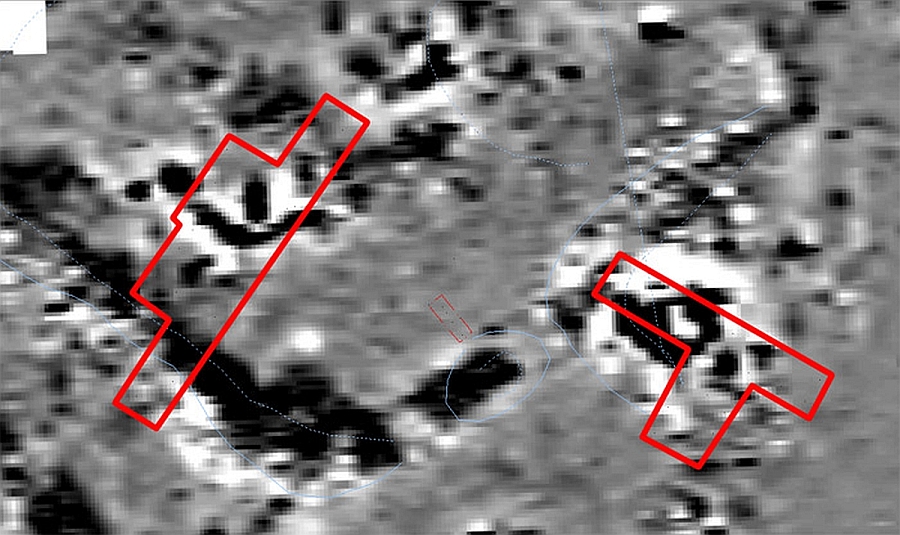 The red lines are from the site survey that was completed on the last day of the dig. They have been superimposed over the magnetometry. Now see below what was under the turf! 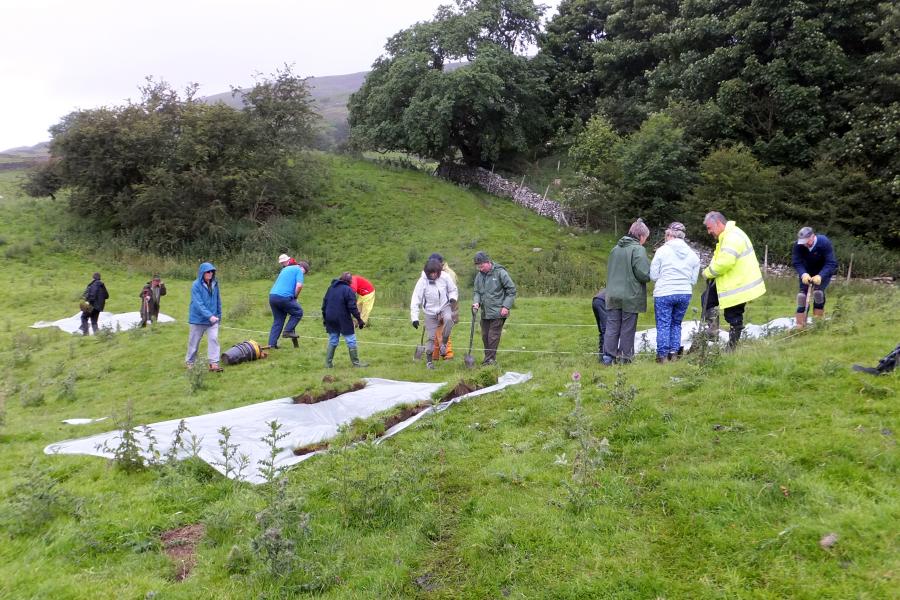 Trench 1 marked out 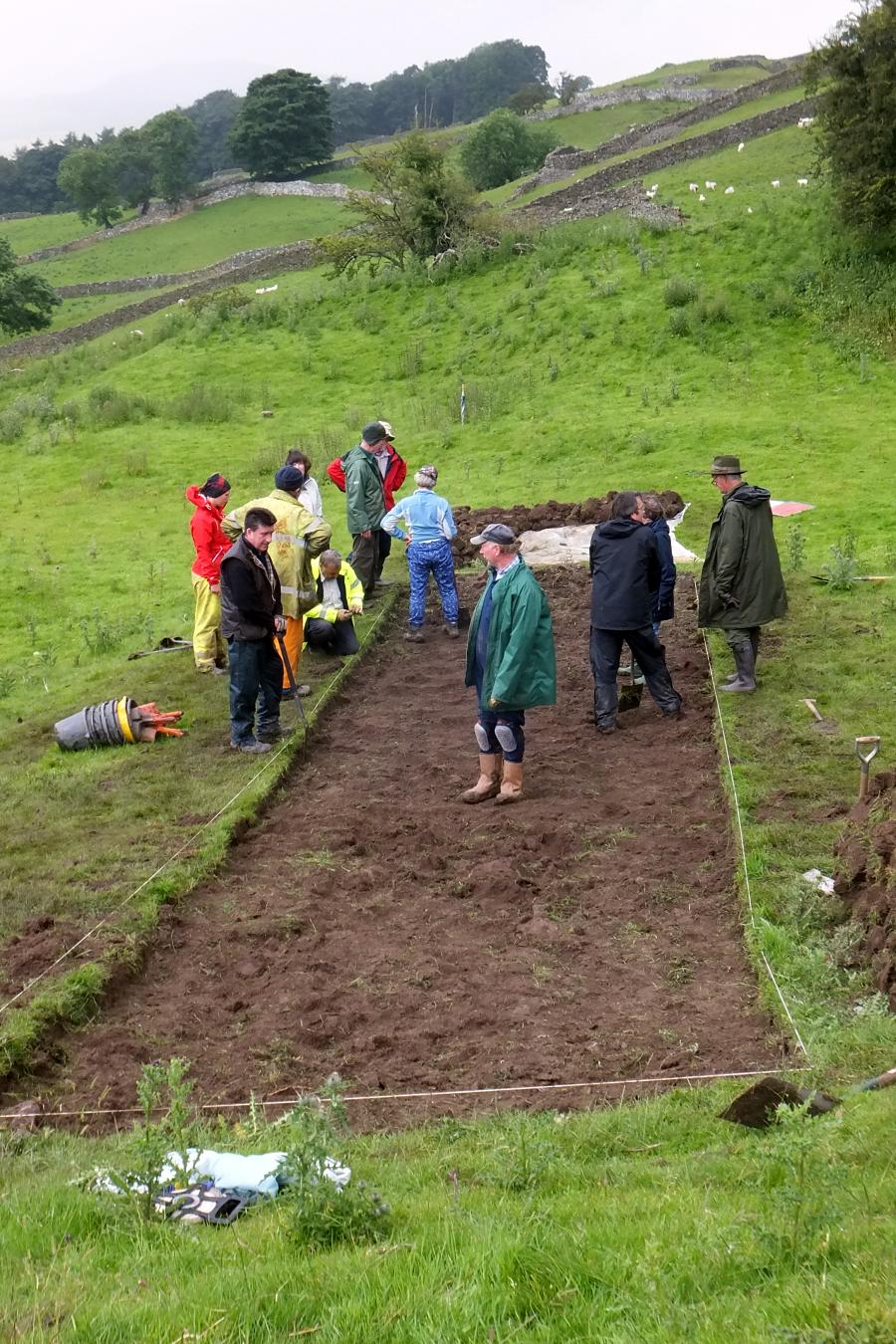 After an hour or so we have it deturfed. 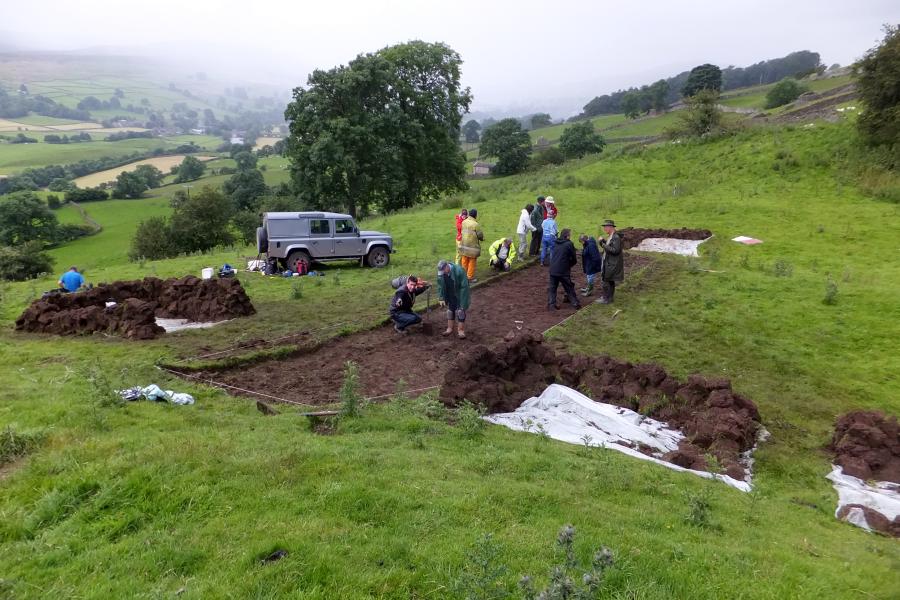 General View of the dig site. 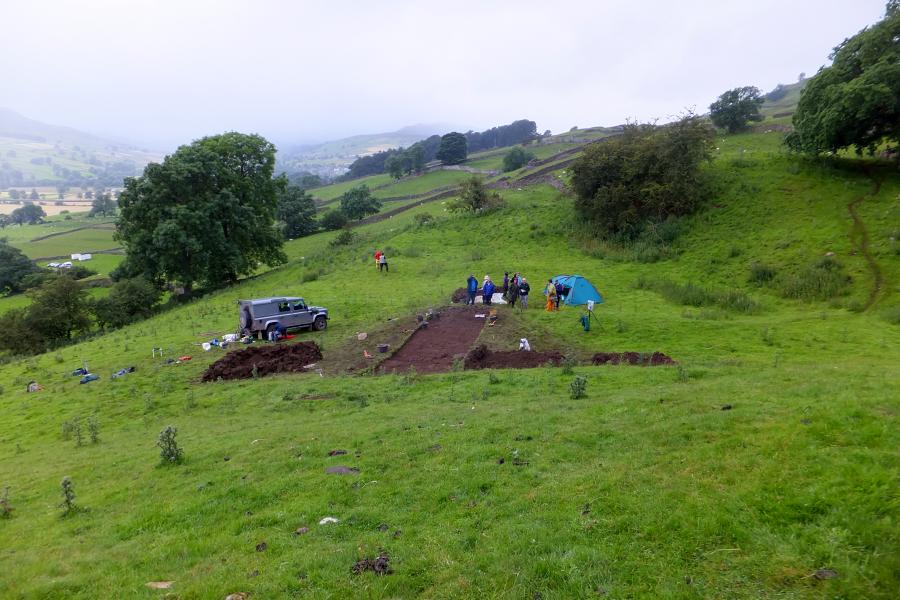 A wider view of the site. Tony and Steph in the background are marking out Trench 2 which will be deturfed tomorrow. 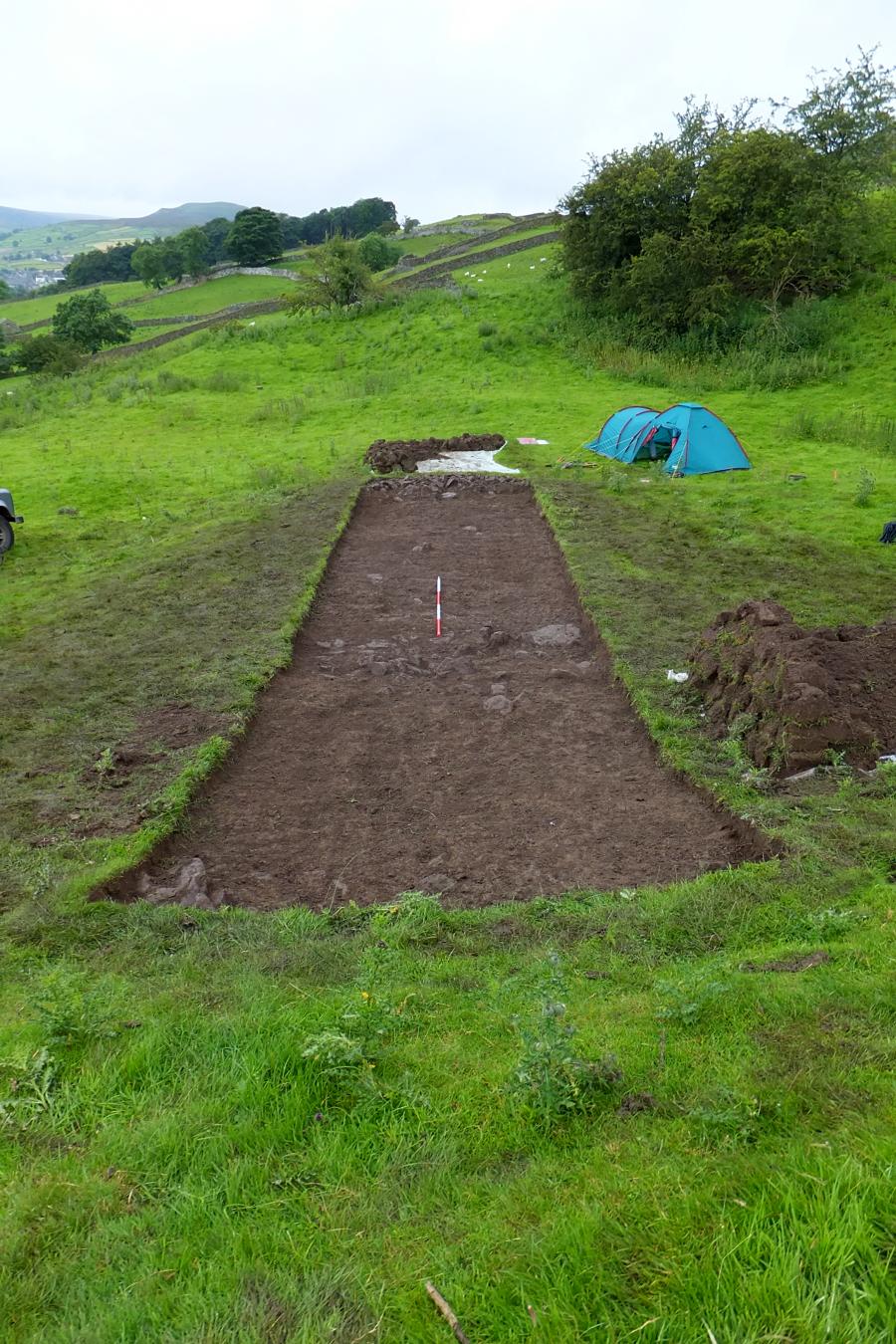 The top soil has been trowelled off revealing what may be 2 curving walls. 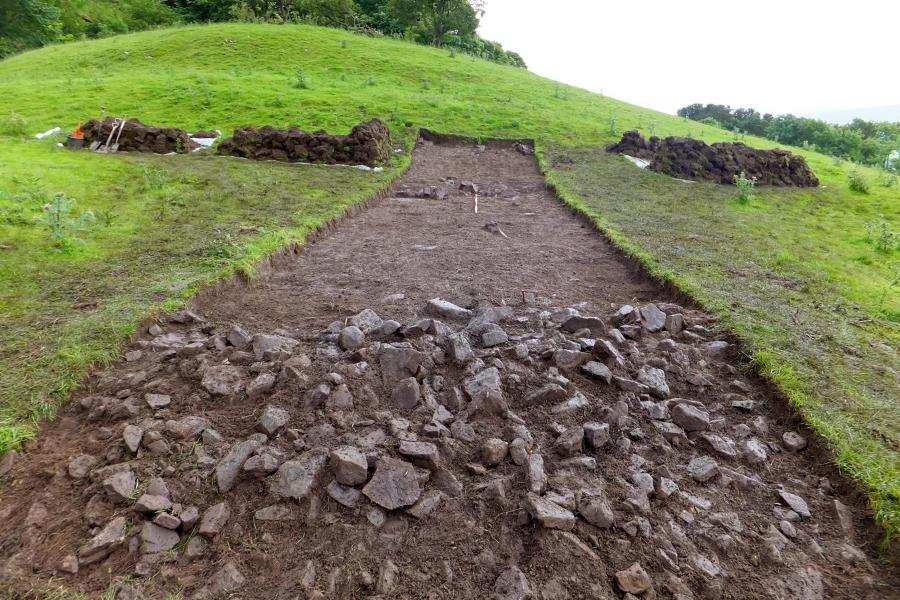 View looking east |
The next 6 images are of the two pottery finds: 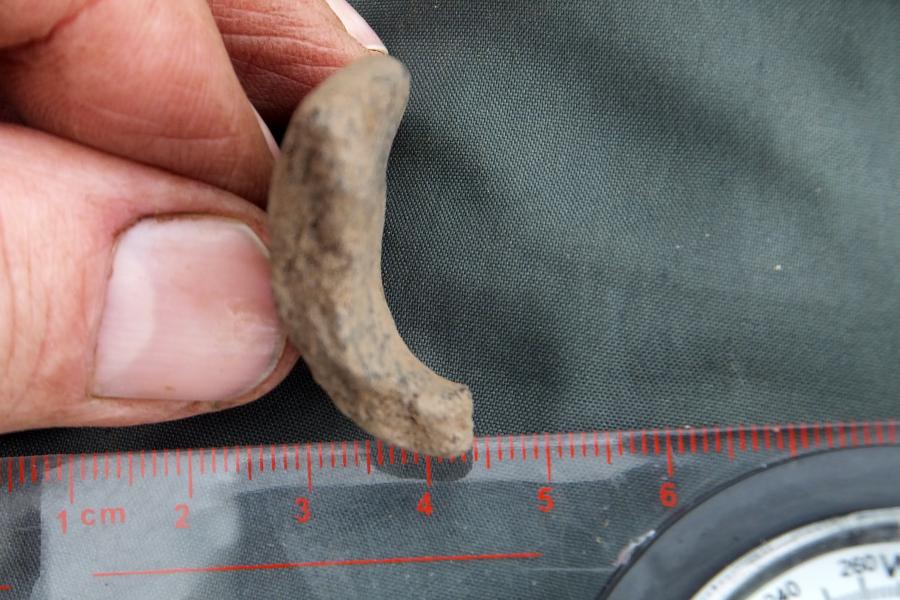 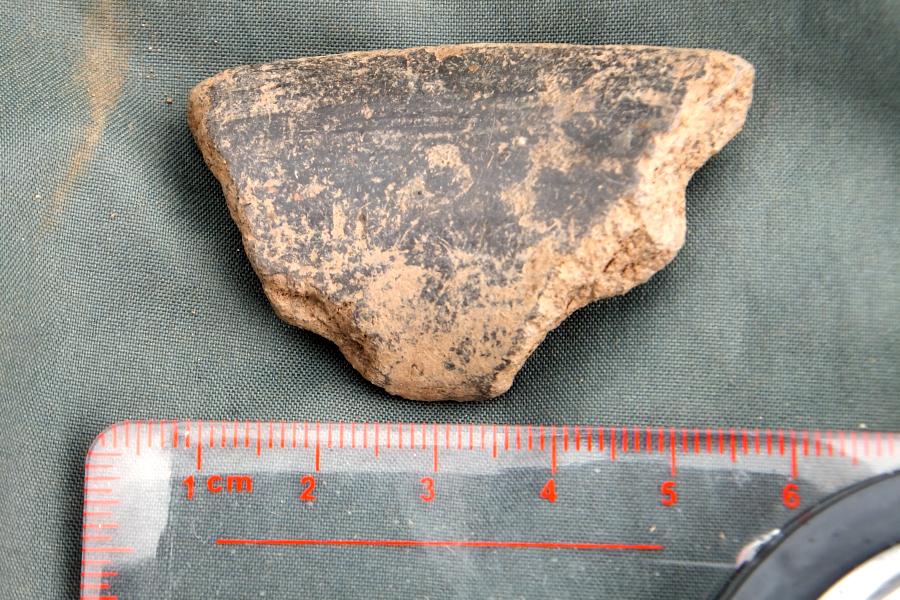 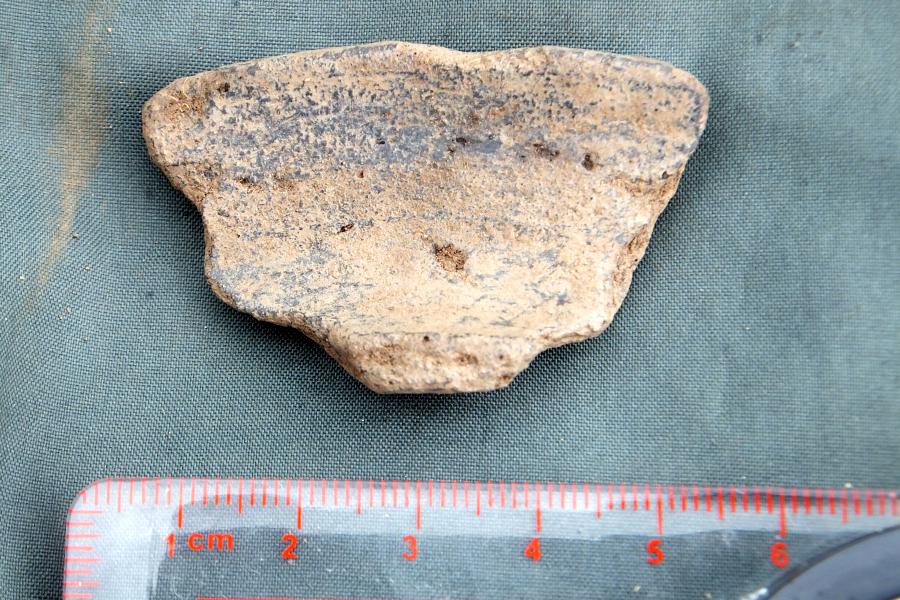 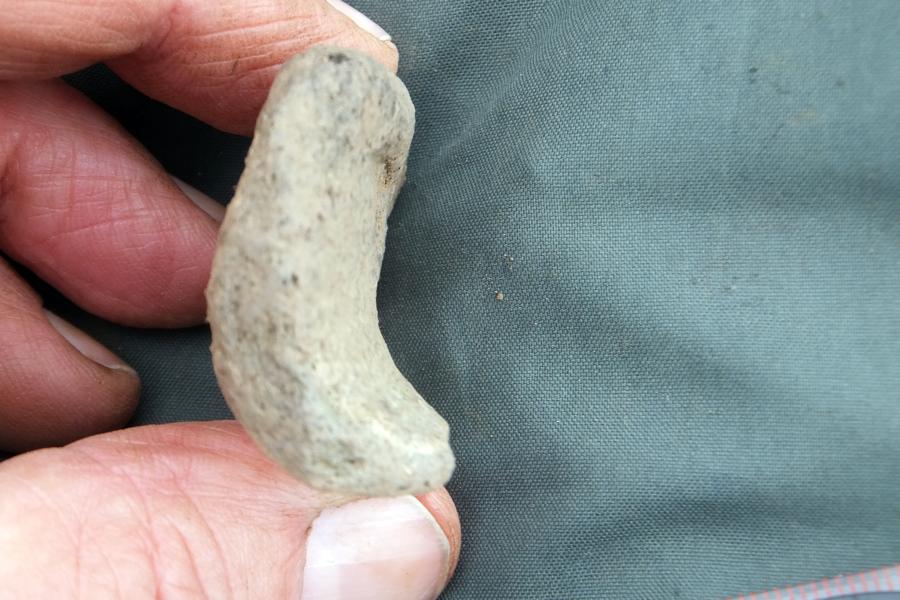 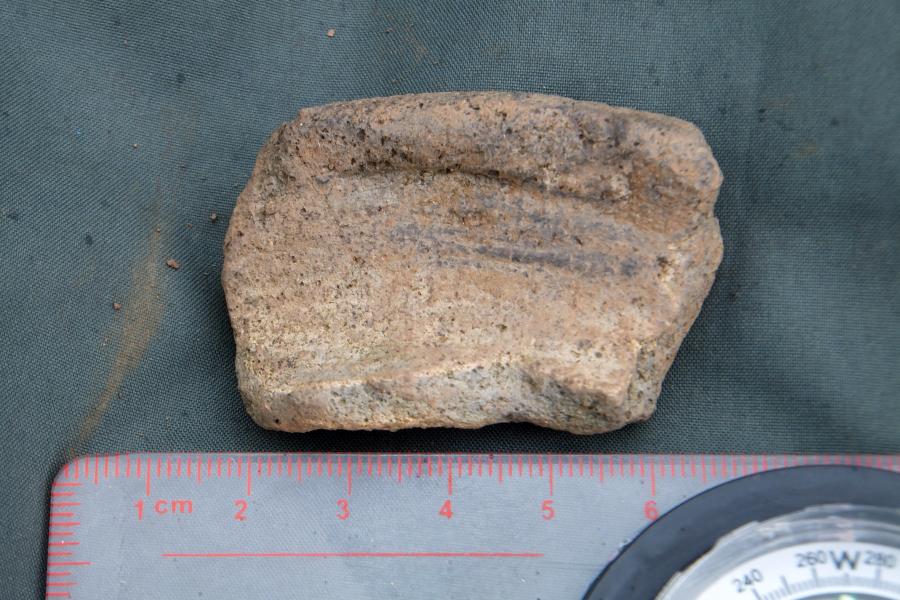 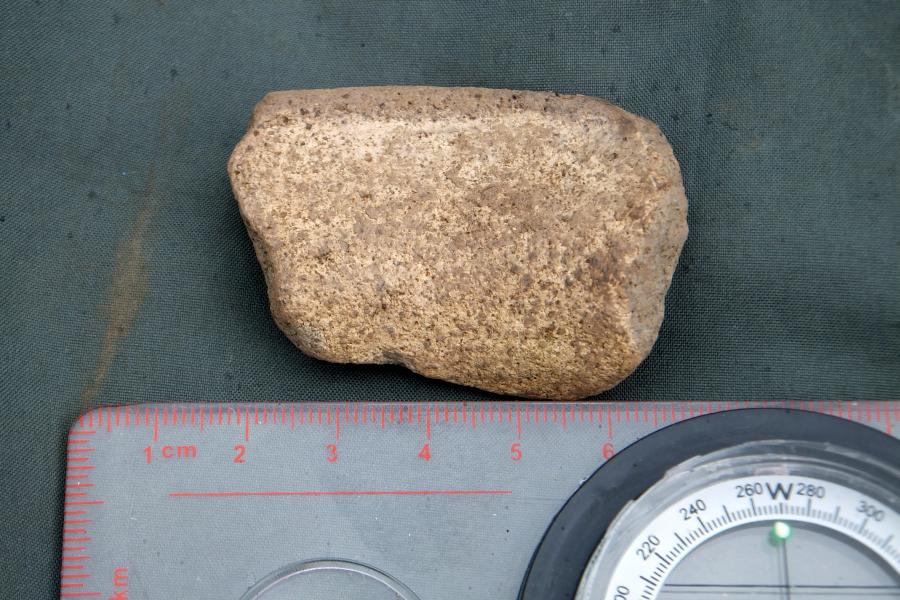 |
|
Day 2 July 17th.
Top of Page The weather was much kinder than forecast with none of the predicted afternoon rain. Great progress was made in de-turfing and opening up the new trench two and in further work in trench one. At one time we thought we had exposed stone flag floors in both but now we are not so sure; at least one might be natural. Further work in the next few days should reveal all. |
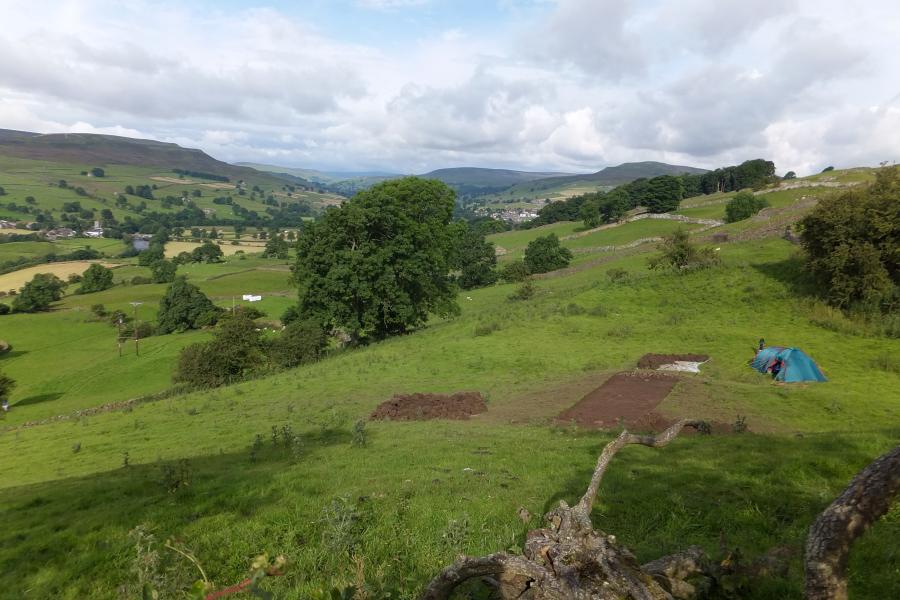 Beautiful morning warm and sunny with a slight breeze. River Swale and Grinton Church on the distant left and Reeth just right of centre. 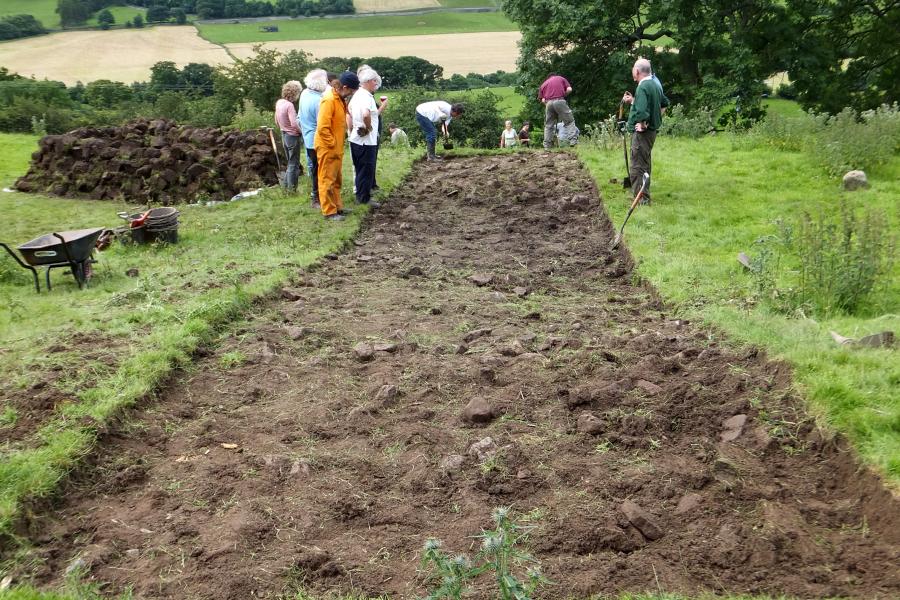 Trench 2 nearly deturfed. 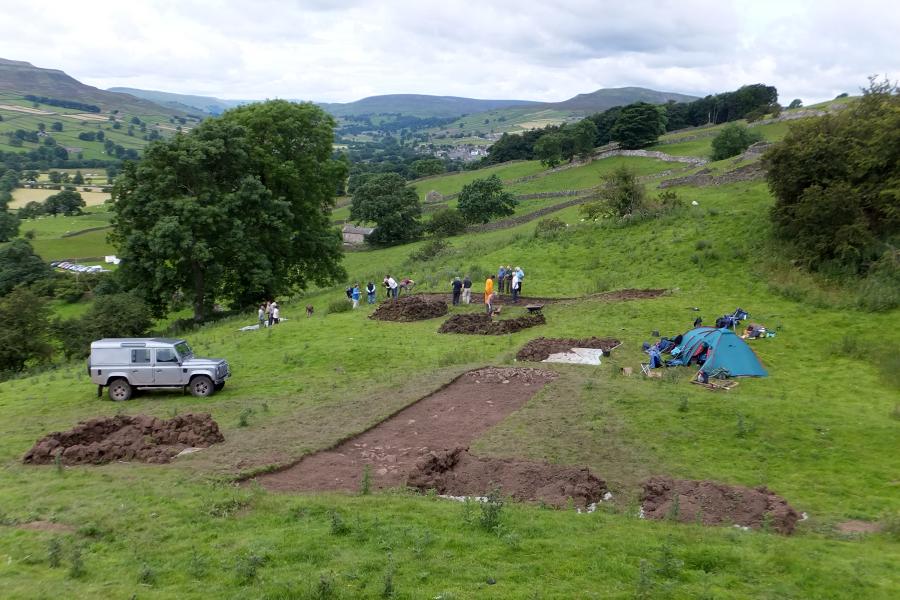 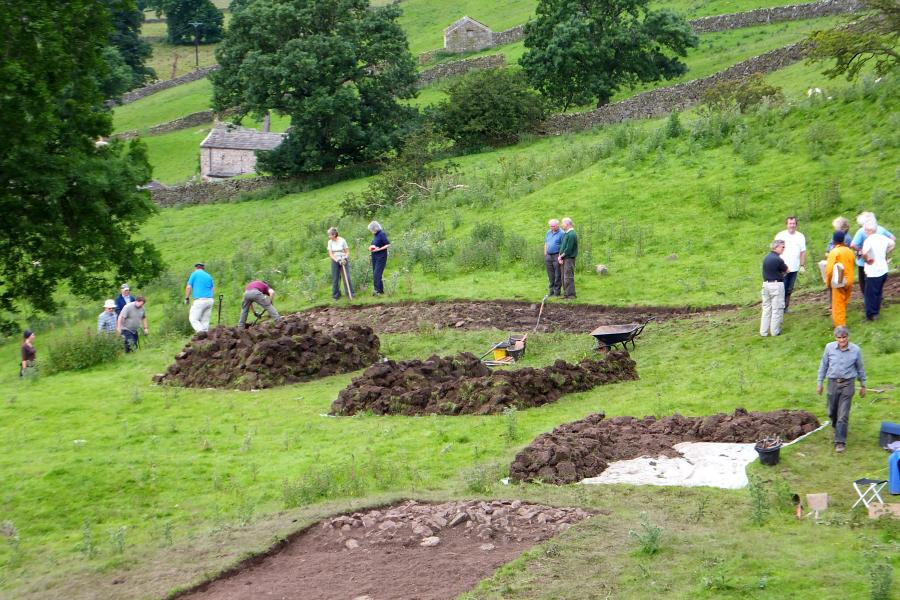 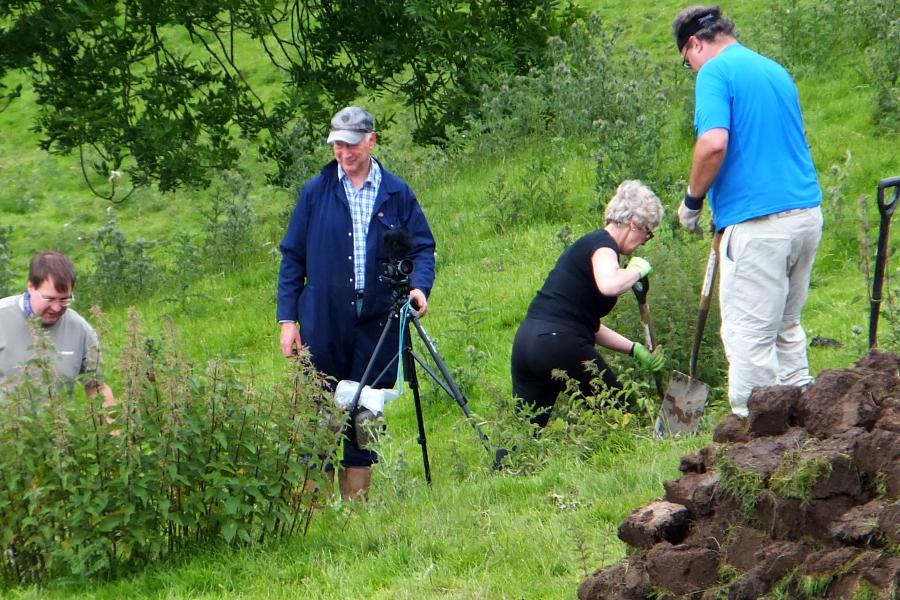 Mike is SWAAGS videographer. Some short clips will be added soon. 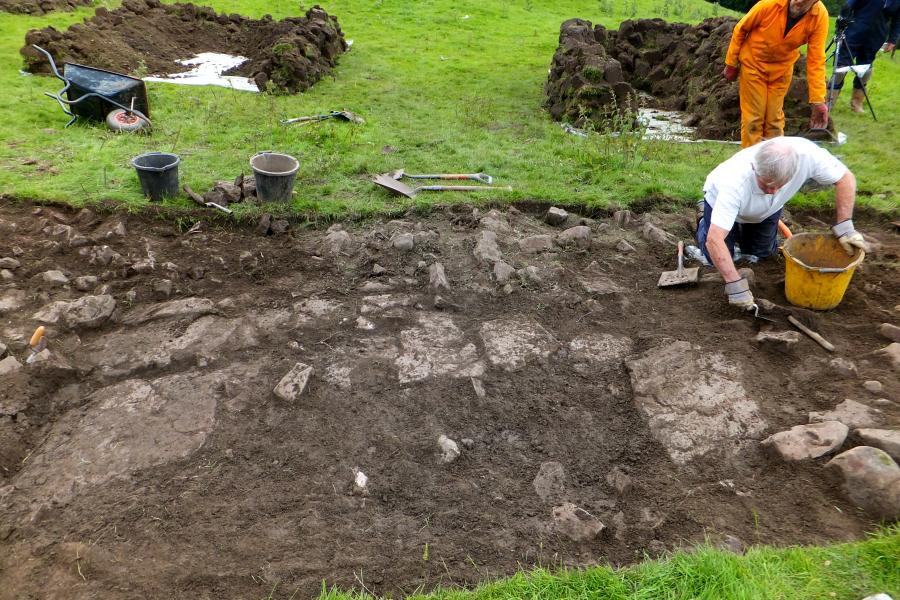 Possible round house paved floor. 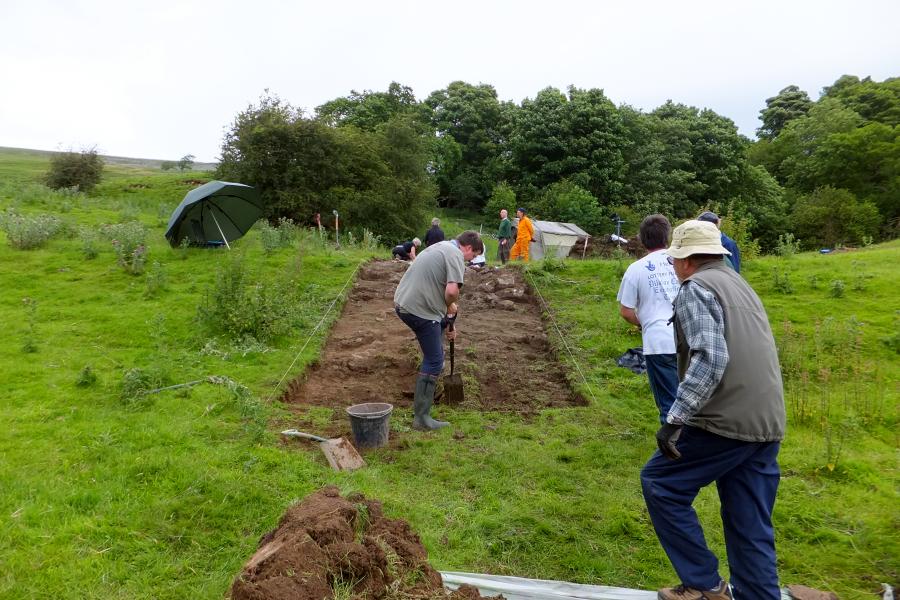 Trench 2: As you can see there is a steep bank below the main settlement site. 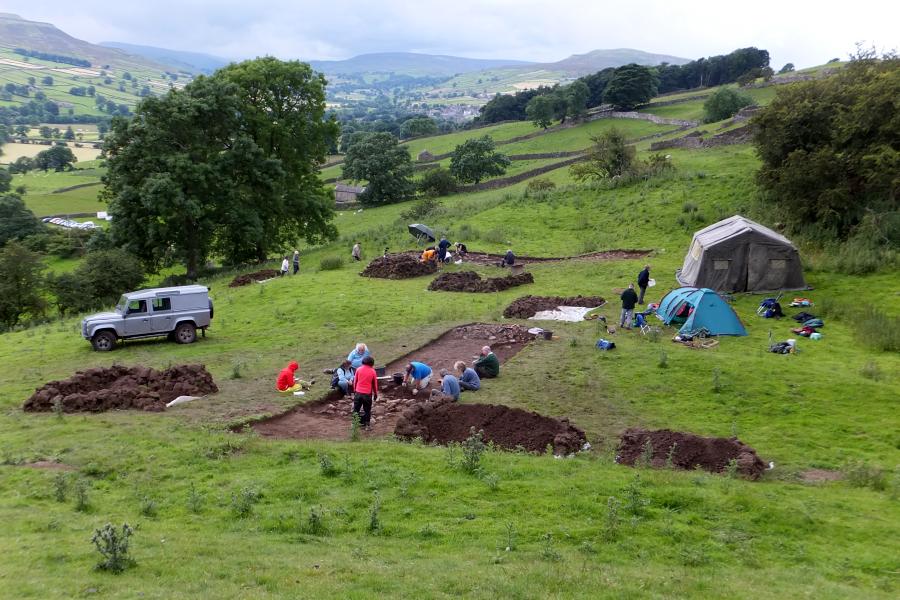 Whilst half are trowelling the topsoil off Trench 2, the others have started to remove the first layer of subsoil from Trench 1. The next 3 images are of a glass ?Roman bangle ?handle found in Trench 2 subsoil by moi. 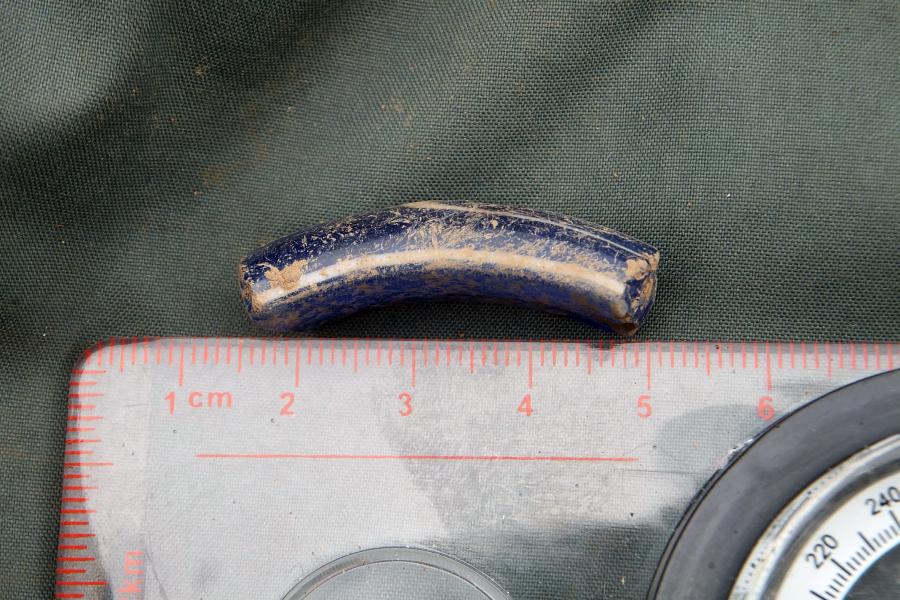 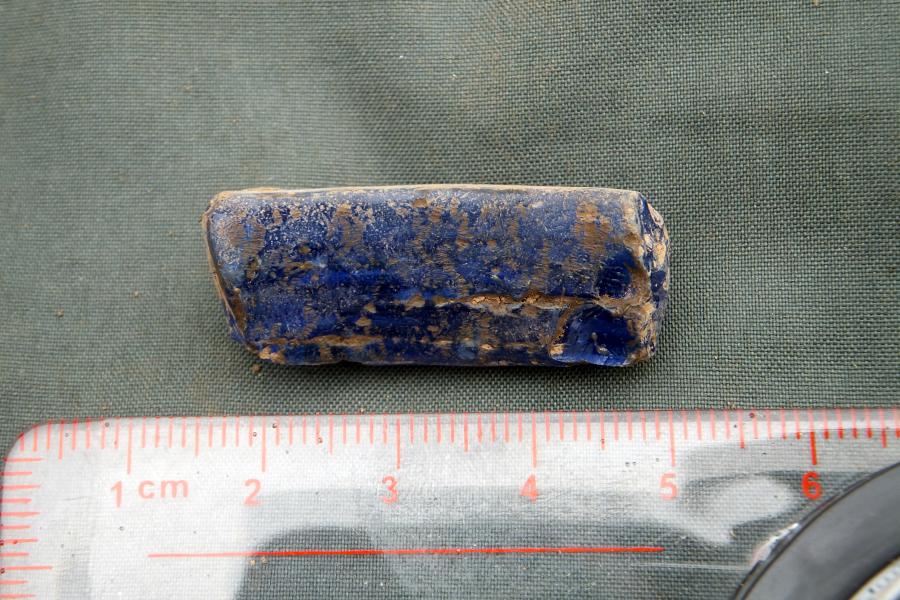 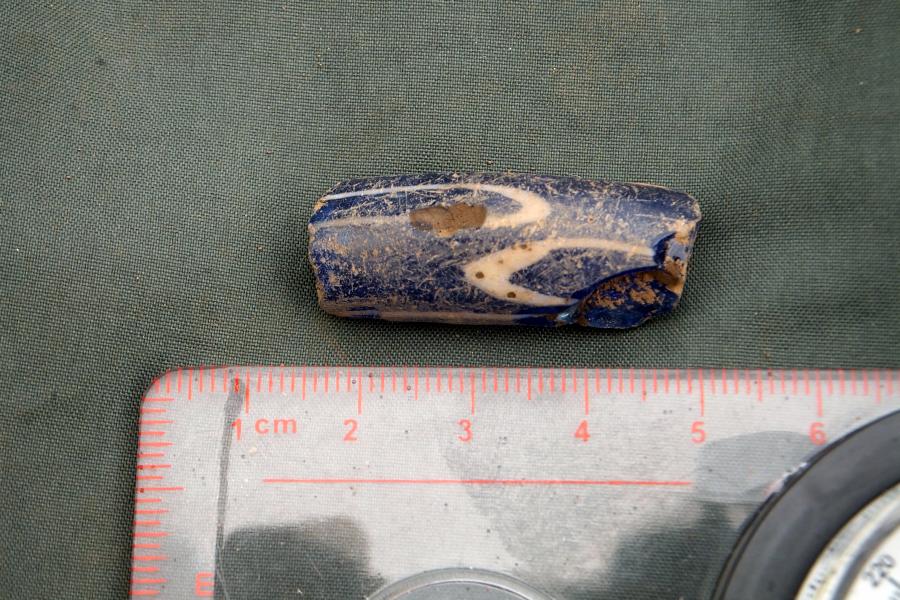 |
| Day 3 July
18th.
Top of Page Much of the day was spent taking trenches one and two down to a consistent level and tidying them up prior to recording. We then decided to extend trench one to the South to determine the extent of the potential flag floor, the apparent wall which overlies it and to see if we can find an entrance into this area. As is often the case, the greatest excitement occurred in the last few minutes when an apparently chiselled slot about 2.5cm wide and deep and visible for about 1.5m across several flagstones was uncovered. There was much speculation about its purpose. We hope to find out more tomorrow as we extend trench two to uncover the extent of the flag floor. |
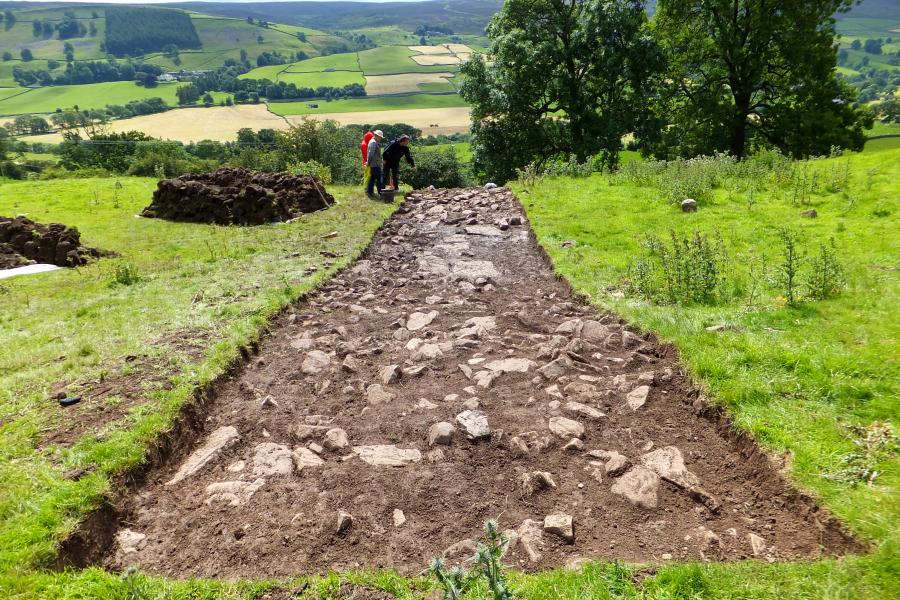 Overnight rain pooled over what we hope will be a round house site in Trench 2. 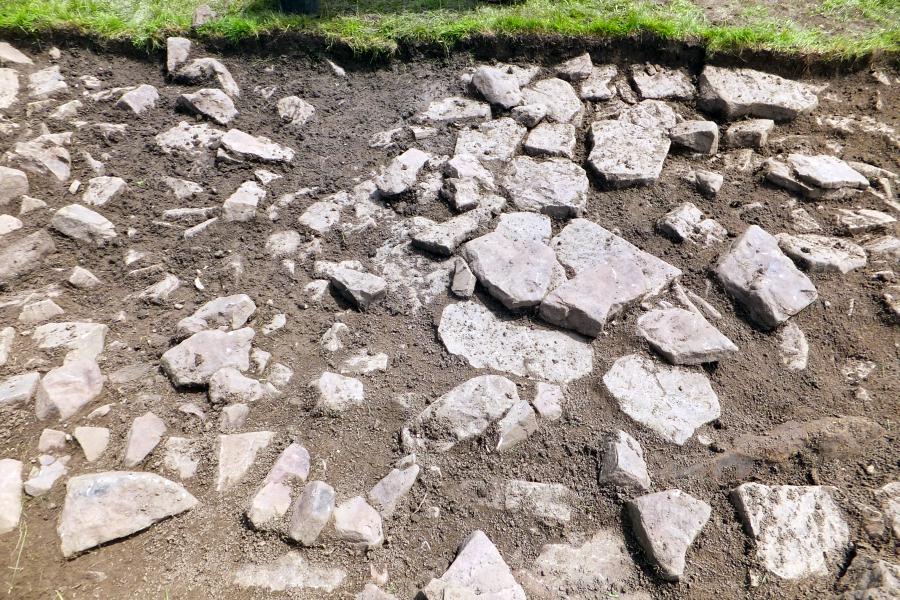 Trench2: In this section there many stone 'flags' that look as though they once fitted together to formed a level surface but subsidence has separated them. This area is just above the next photograph. 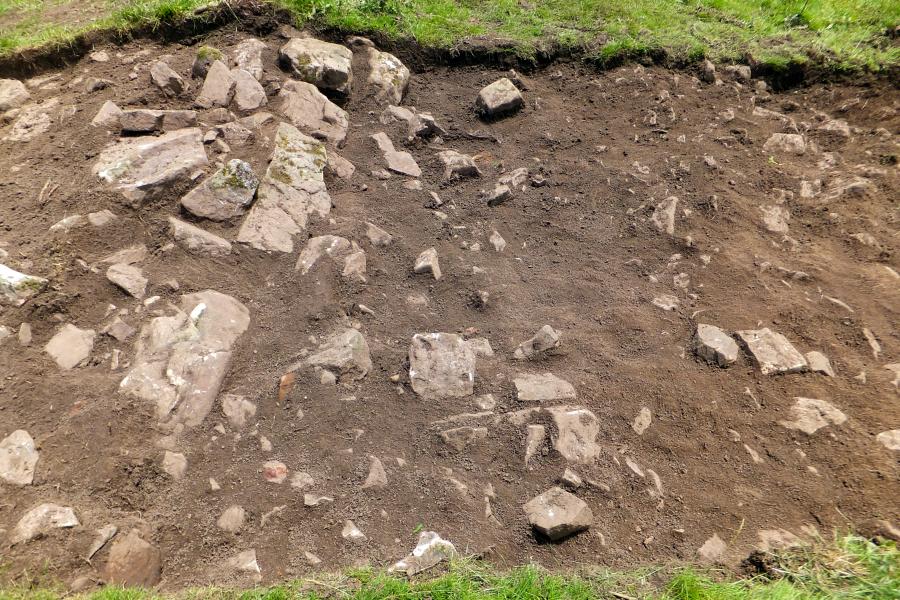 The far end (South) of Trench 2 shows signs of subsidence. The above bank covers a revetted wall to stabilise the ground. 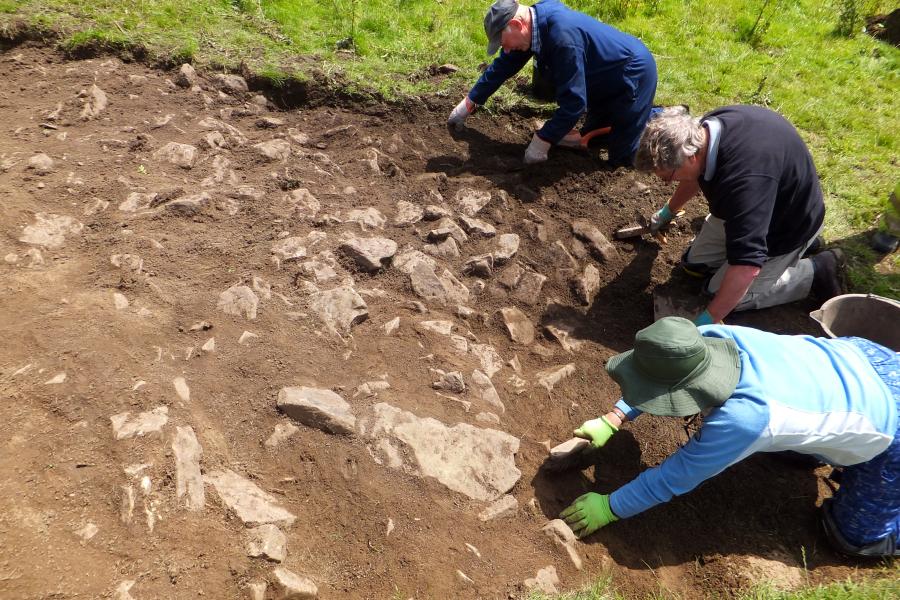 Trench 2: showing the southern end below the revetted wall. 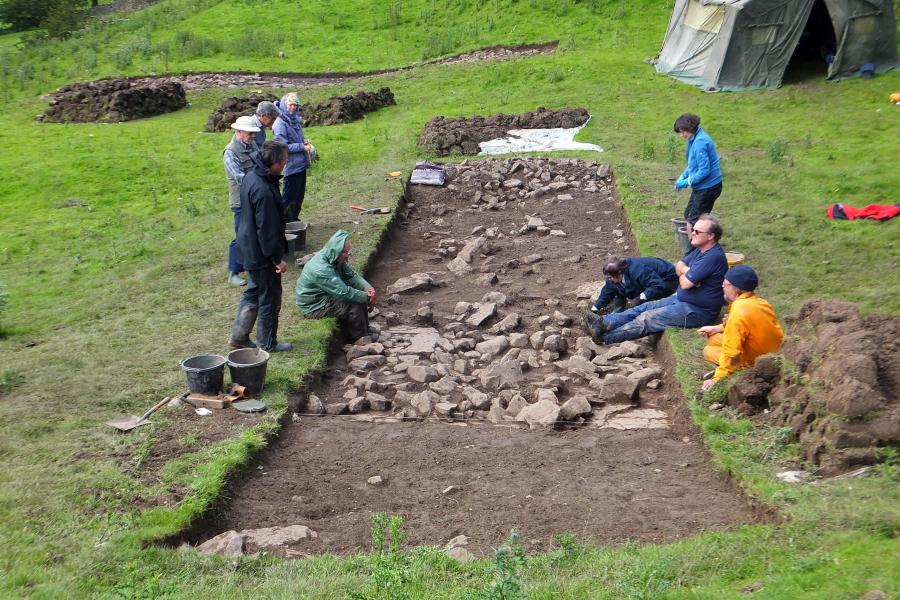 In Trench 1. everyone taking a breather after nearly trowelling off most of the first layer of subsoil. 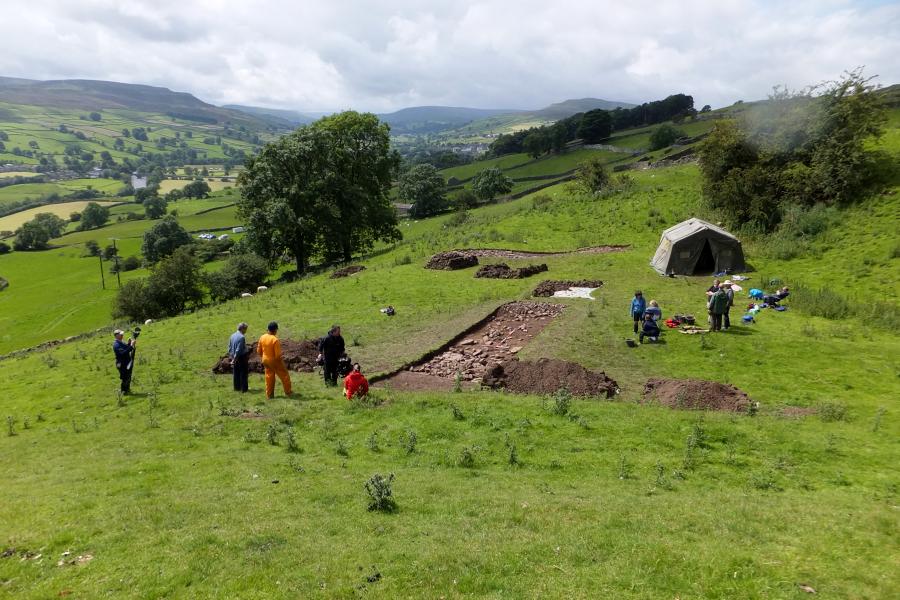 Trench 1 ready for recording although the area of soil nearest the camera is yet to be removed. It may not be necessary to remove it all. 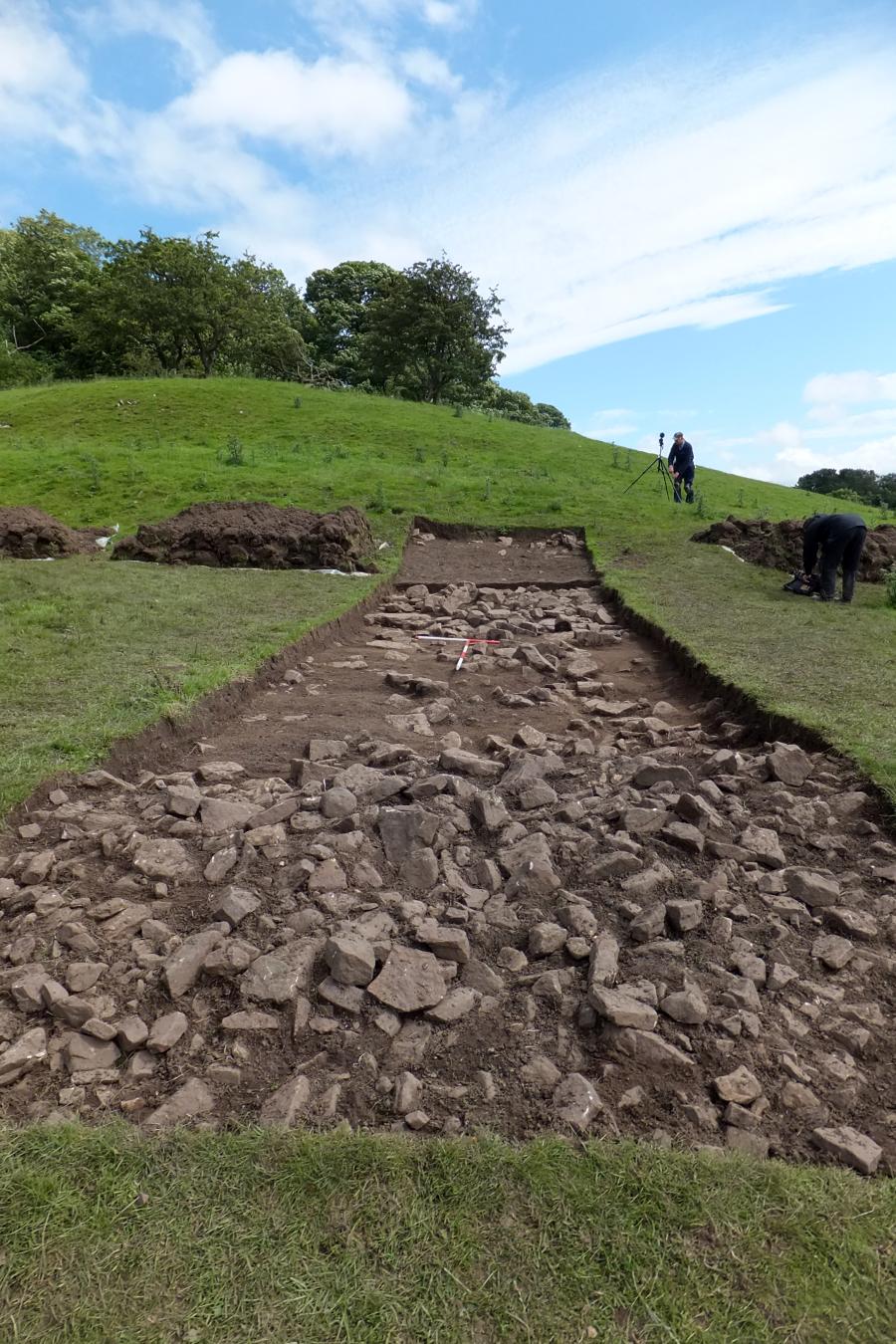 Trench 1: The area above the poles looks like another 'floor' that has random rubble scattered all over it. 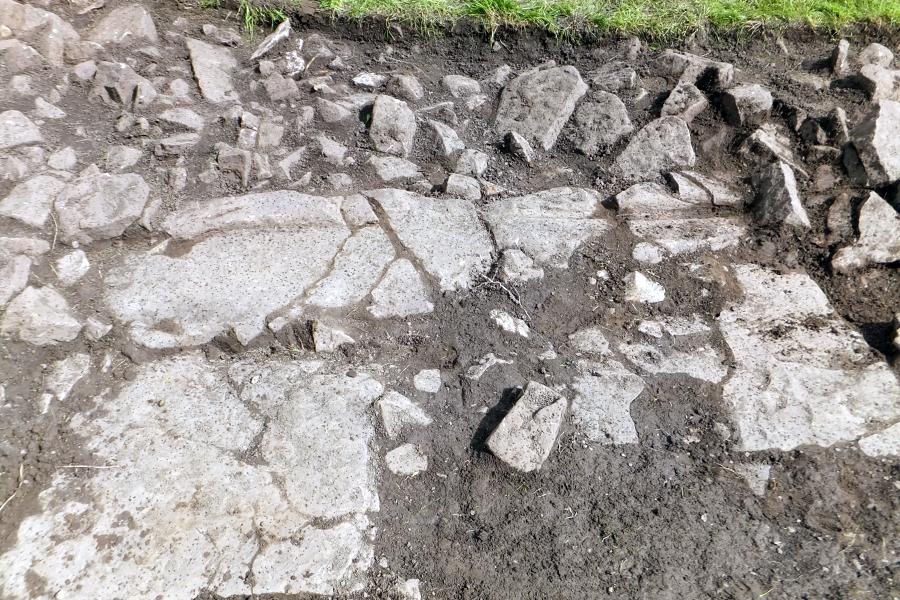 Trench2: The grove along these floor slabs is our first real indication of human activity. We have no dating evidence at this level so far. 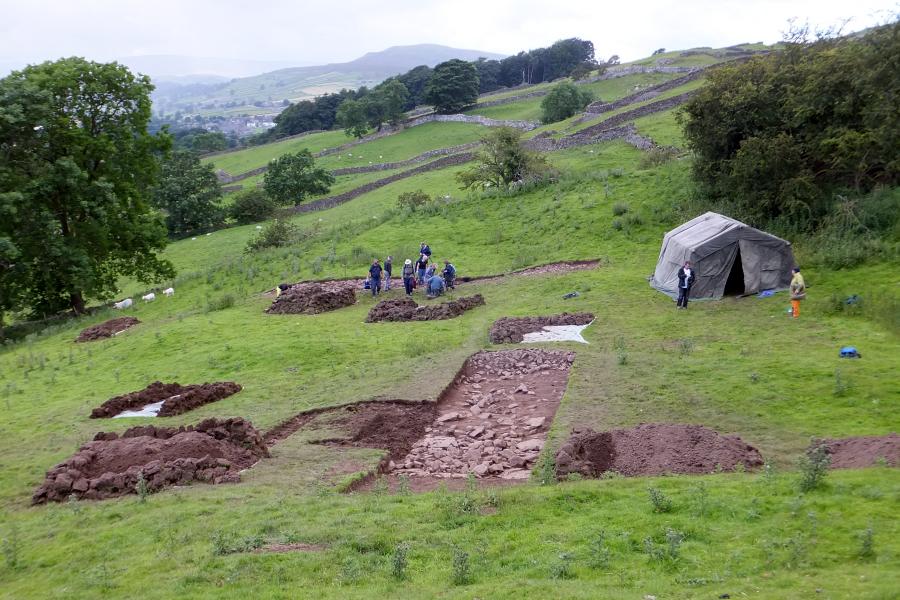 Trench 1. At the end of the day we have started to deturf an area to the south of the large stone 'floor' slabs. First indications are that the stone bank at the far end of the trench appears curve around towards where we are removing the turf. It is very like that we will extend this to the north of Trench 1 too. |
|
Day 4 July 19th.
Top of Page A very successful day which started out quietly with work continuing in trench two to explore the extent of the two flag floors and similarly in trench one to explore the extent of the possible floor to the South, the extent of the wall and whether there is an entrance in this southern section. During the day we found several more pieces of probable native Romano-British ware in both trenches, including two small pieces of rim from trench two which fitted neatly together. In the afternoon trench one yielded some probable Iron-age pot whilst the star pieces were two potentially Roman pieces also from one. |
 Lunchtime Day 4 we have made progress with the southern side trench to Trench 1, and also removing the next layer of soil nearest to the camera. 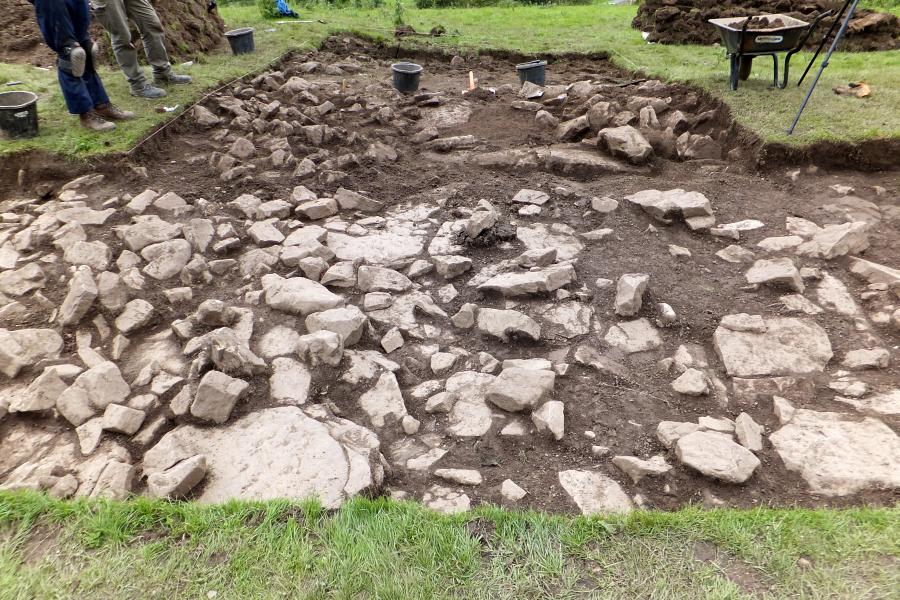 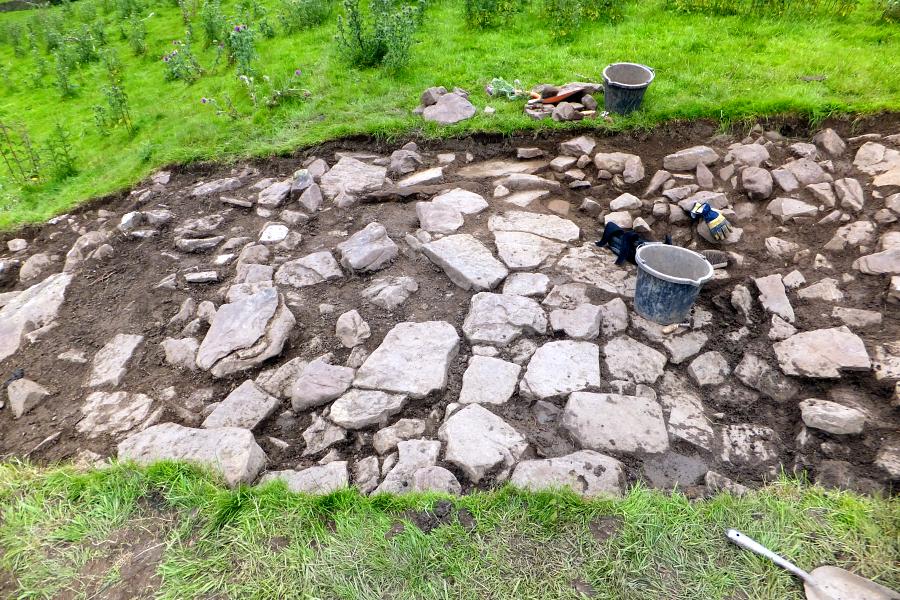 In Trench 2 the southern paved area is being prepared for recording. 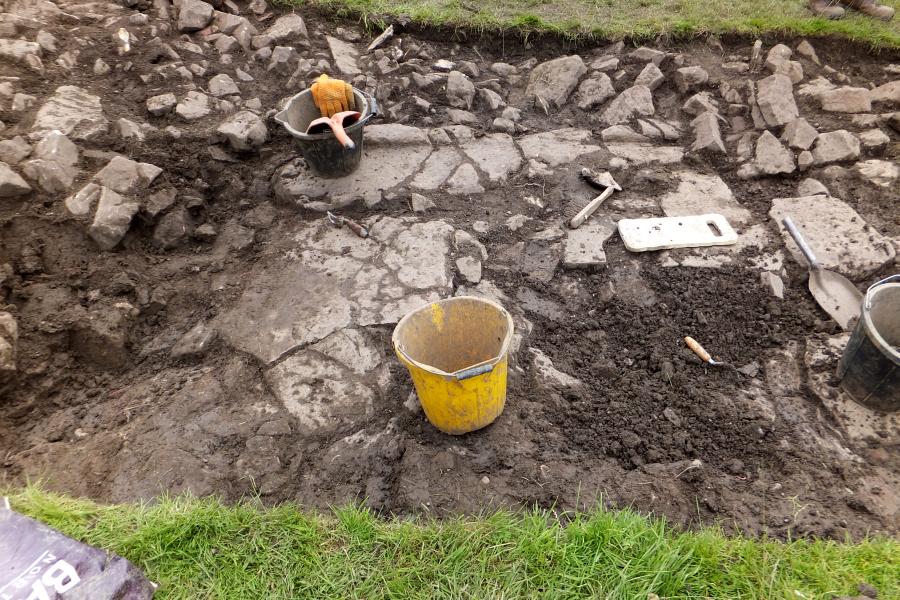 In the centre of Trench 2 the possible round house floor is being defined further in preparation for extending the trench towards the camera. 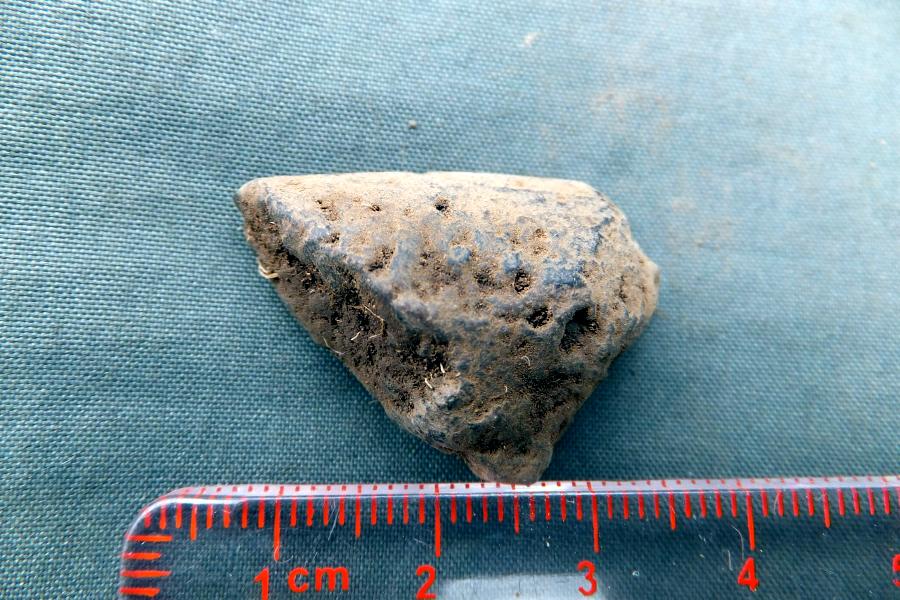 Justin's first fragment of Iron-age pottery that he has excavated. 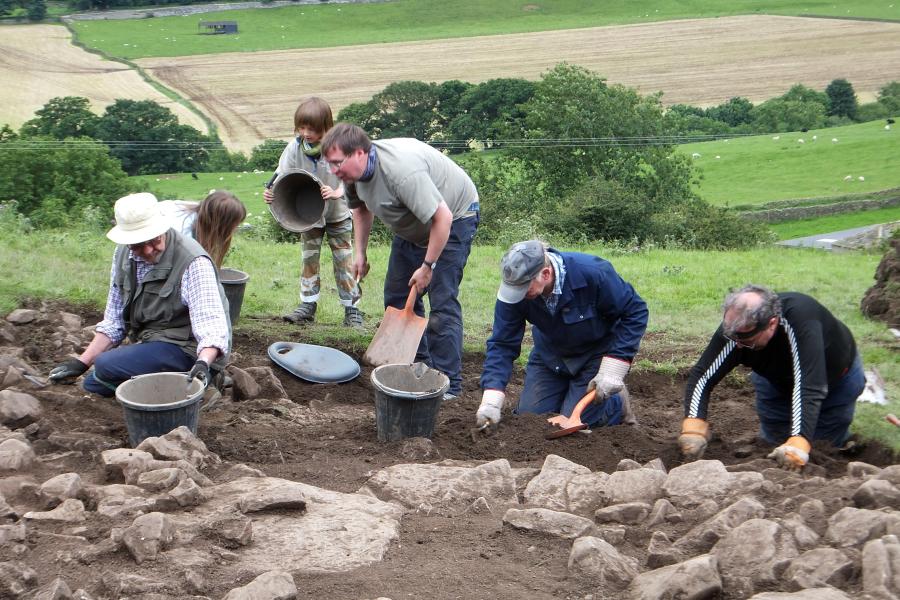 Justin supervising his two children Tasmin and Harris. 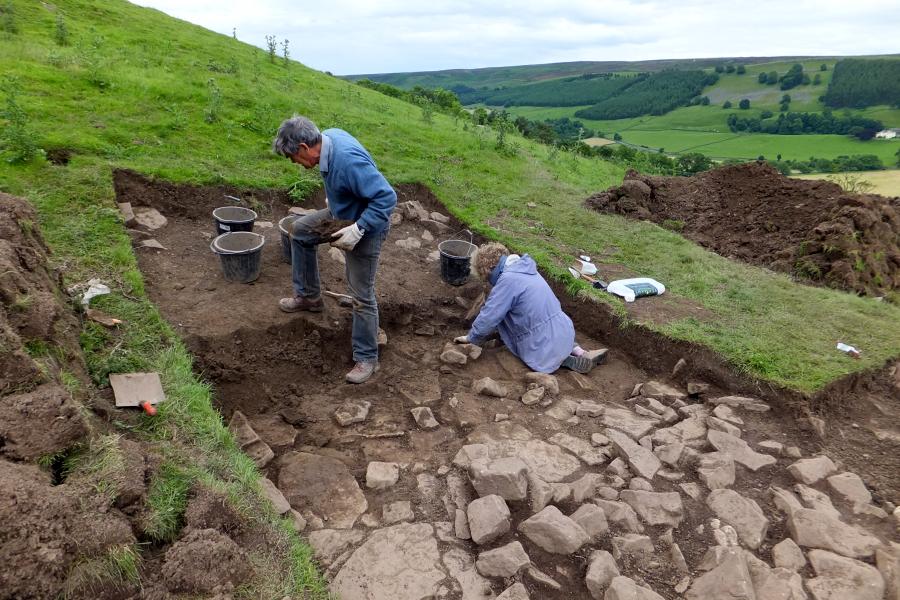 Dustin and Katharine working on the eastern end of Trench 1. His is standing over where he will shortly find the possible Roman period piece of pottery. 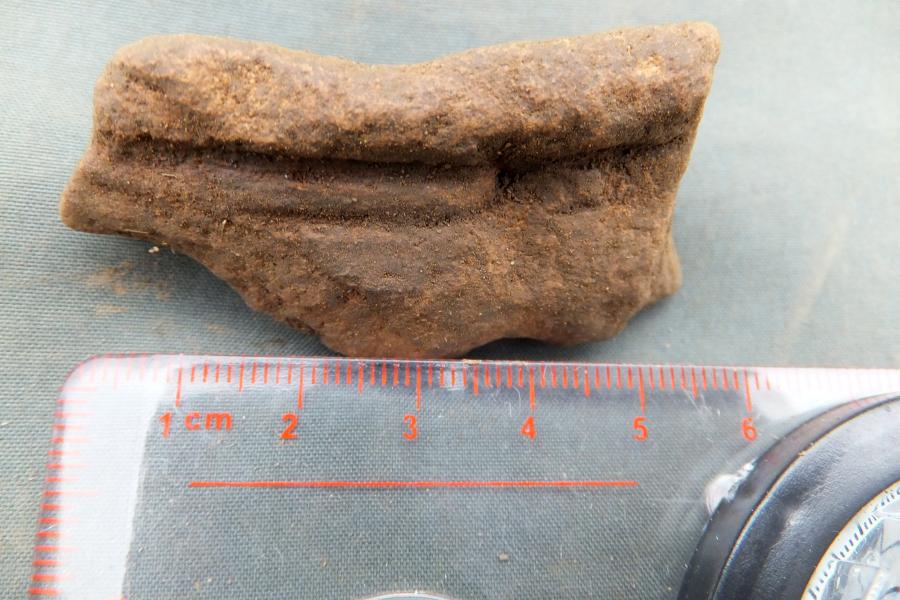 ?Roman period pottery fragment.  Dustin's ?Roman period pottery fragment.  End of Day 4: Trench 1. 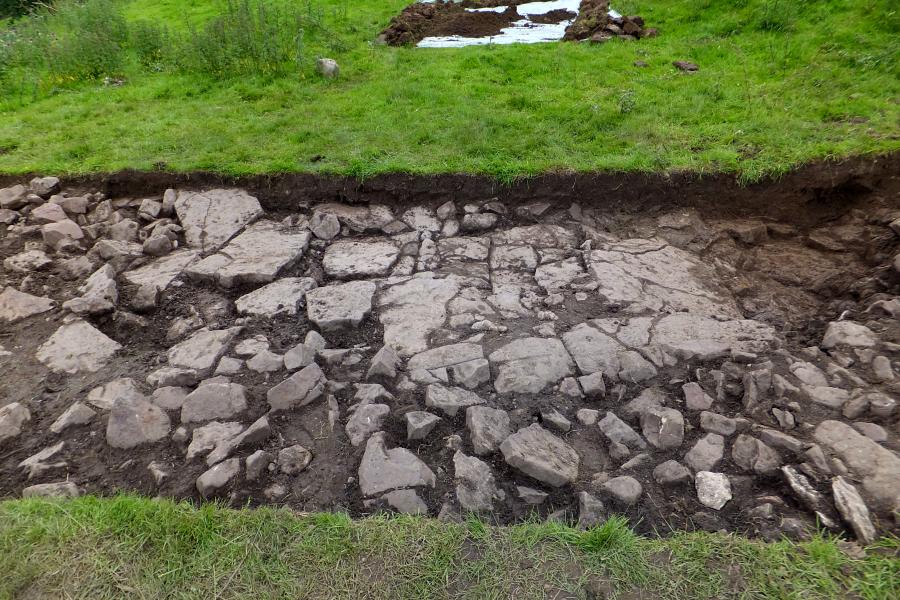 End of Day 4: Trench 2 Possible round house site. |
| Day 5 July
20th.
Top of Page An interesting day, not so many finds but we are beginning to understand a little better what we are uncovering. |
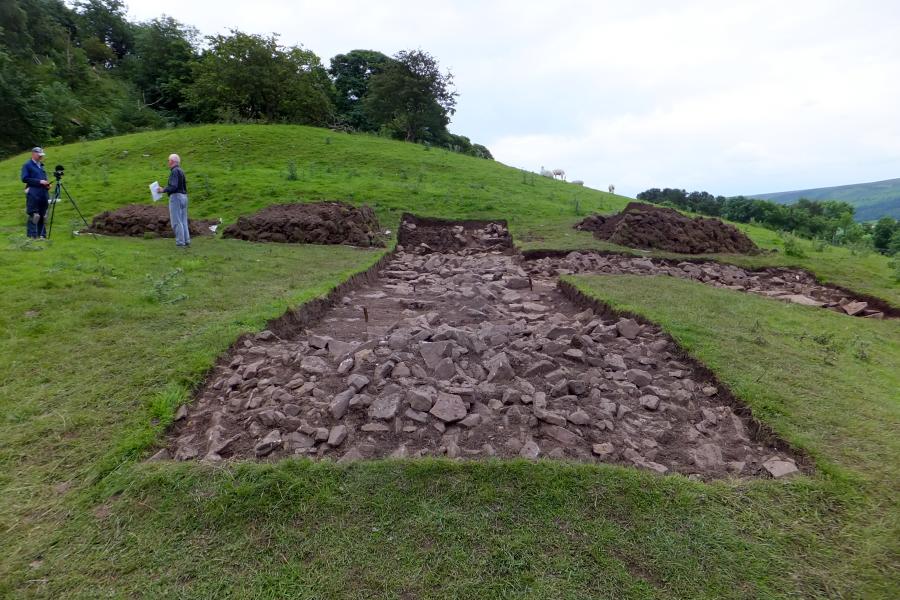 Alan doing a piece to camera beside Trench 1. The short videos for the first 5 days will be gradually inserted into the blog over the weekend. Note the southern extension to Trench 1 on the right. See below. 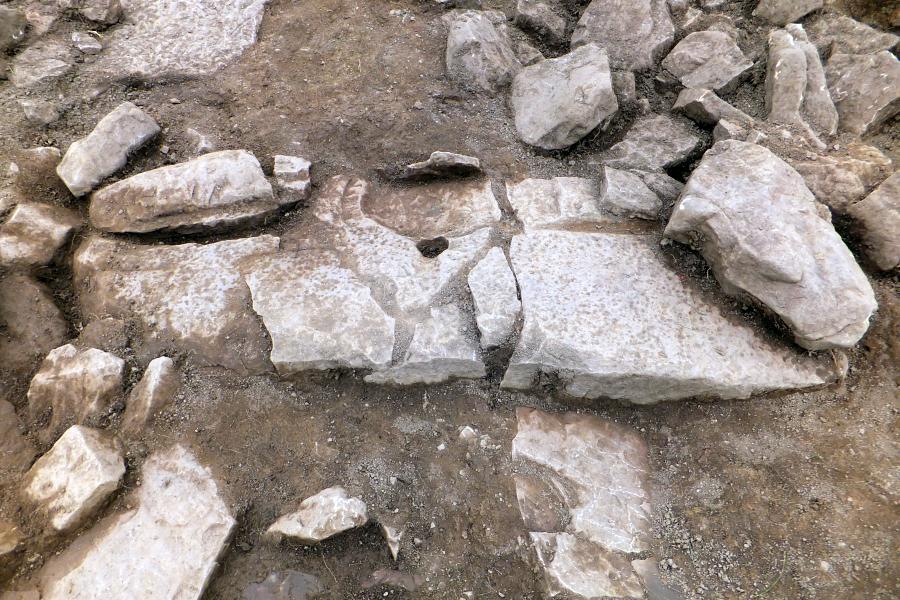 Trench 1: Southern extension. We are not sure what we have here as there is no obvious roundhouse structure. Like Trench 2 we now have a similar slot and hole across what we assume to be the entrance. Trench 1 will be extended towards the north next week. 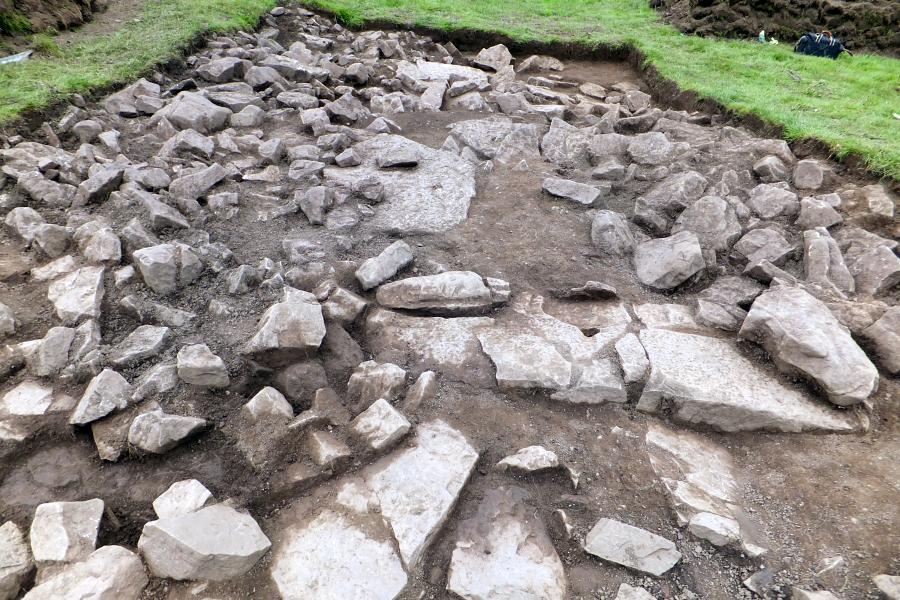 Trench 1 southern extension down slope  Trench 1: The stone bank at the far end gradually bends around and stops at the right side of the 'entrance slot' in the southern extension as shown in the previous image. 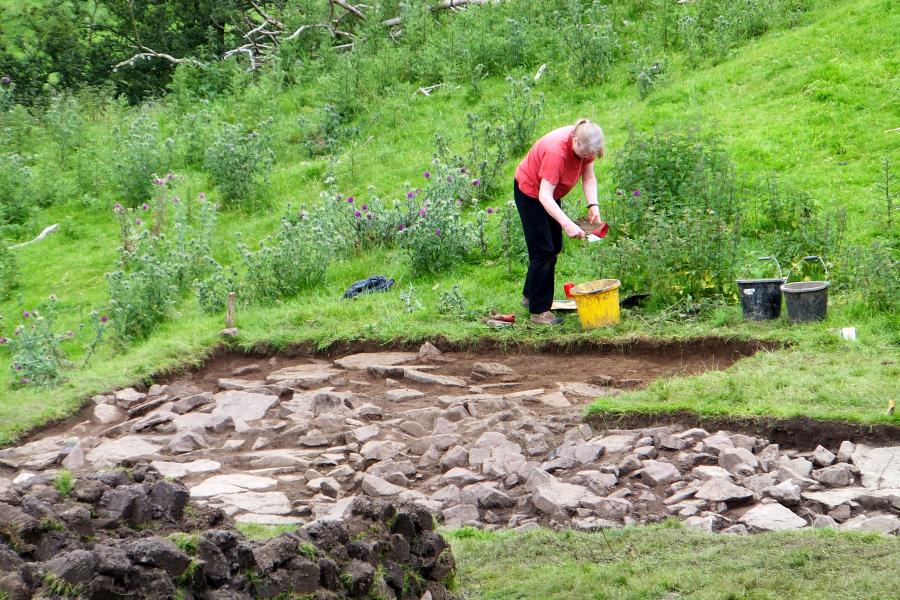 Trench 2: Is being widened on the west side. In the area by the yellow bucket 2 small flints were found in the top soil. The nearest source of flint is on the Yorkshire East Riding coast. The bottom left of this trench, slightly hidden by the stack of turf, is a roundhouse base which appears to have subsided down the bank at some stage. The second roundhouse is immediately above it and separated by a stone bank. 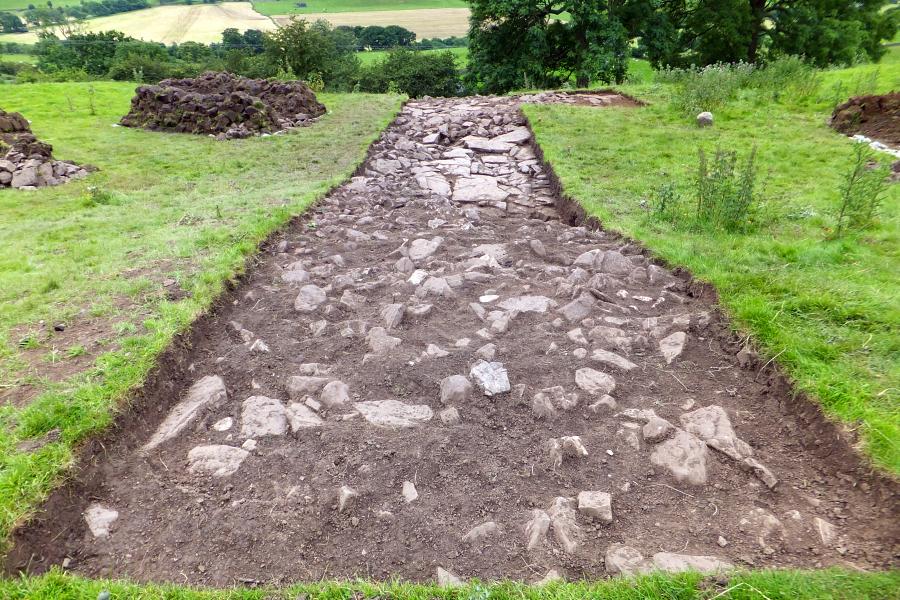 Trench 2: At the far end the widening has started. Now the roundhouse has been defined just below those nettles on the right, it will be extended next week up to there, or even wider if indicated. 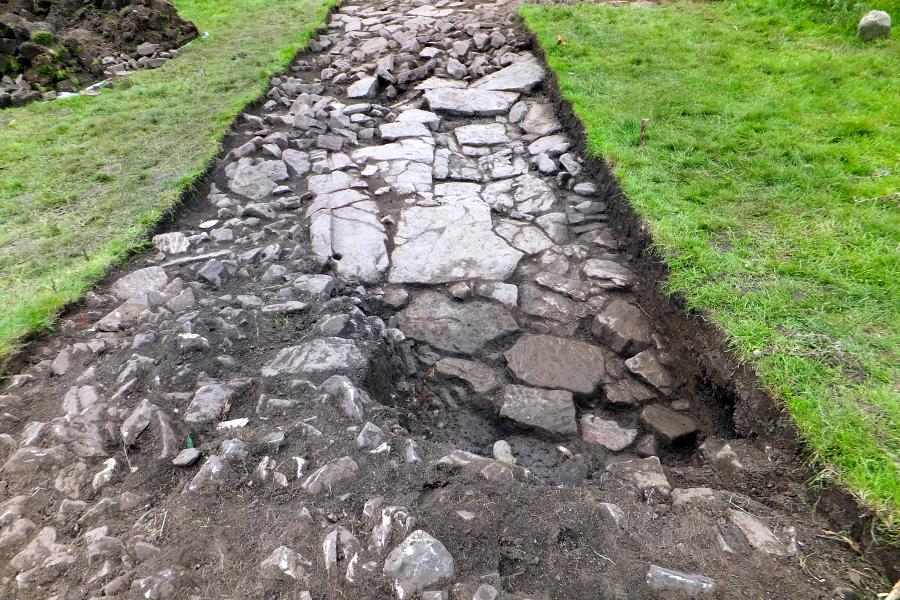 Trench 2: Showing nearly a semi-circle footprint of a roundhouse with a eastern facing entrance indicated by the slot and hole in the stone. We now have 2 days for our aching hands and back to recover before starting week 2. The amount of recording we have to do will limit how much we can extend the trenches. |
| Week 1 Video |
| Sunday morning July 22nd: Establishing dig site elevation from an OS spot height on the road below Hagg Farm. |
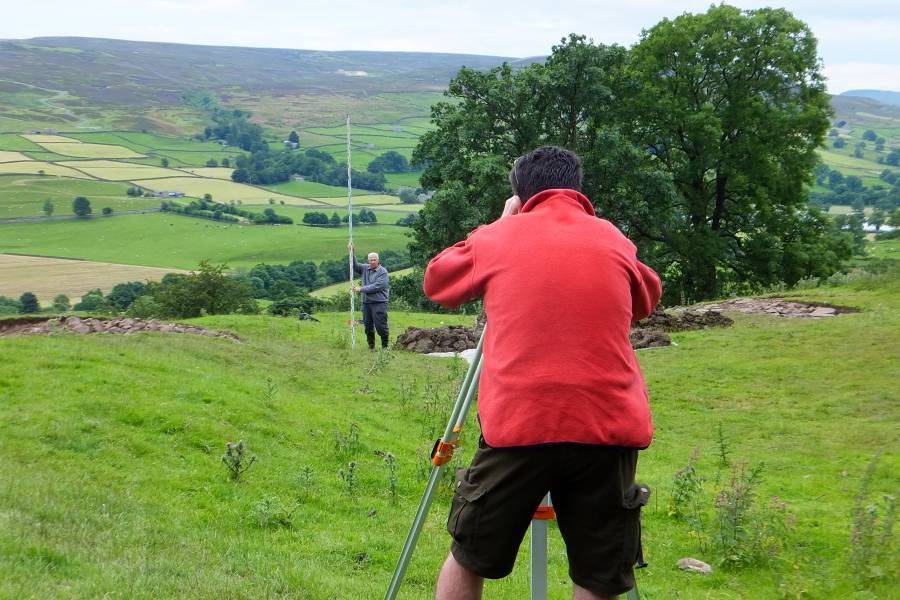 |
| Day 6
July 23rd.
Top of Page Today was a day of relatively high winds which thankfully kept the midges at bay. We have taken Trench 1 down to the abandonment phase and made a start on recording what has been revealed. In Trench 2 an initial 2 metre wide extension to the trench centred on the upper roundhouse is nearing completion. It is very likely we will need to further extend its width another 2 metres to fully reveal the floor plan of the roundhouse. |
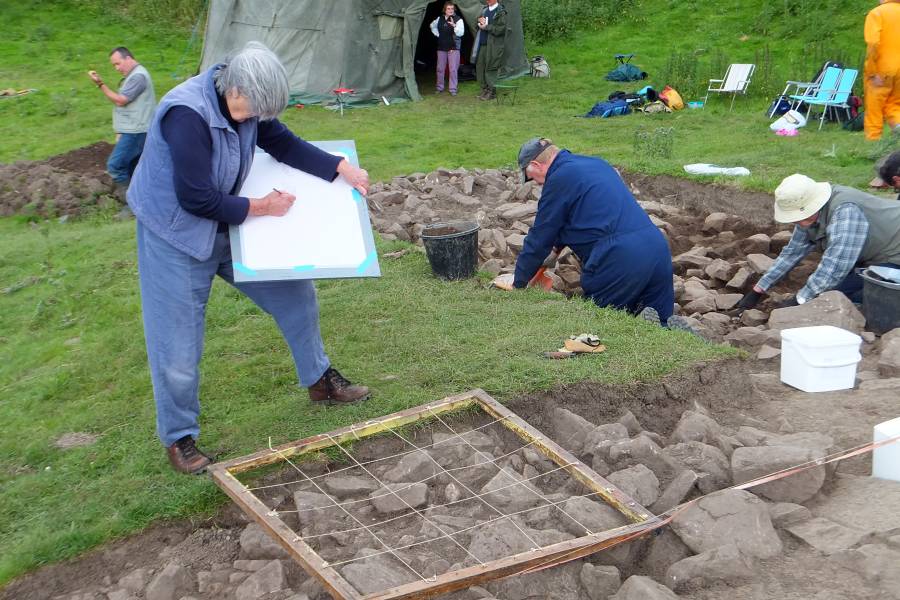 Jocelyn busy recording the southern extension to Trench 1. Please look at Jocelyn's watercolours and sketches under the Artwork tab on the menu bar. 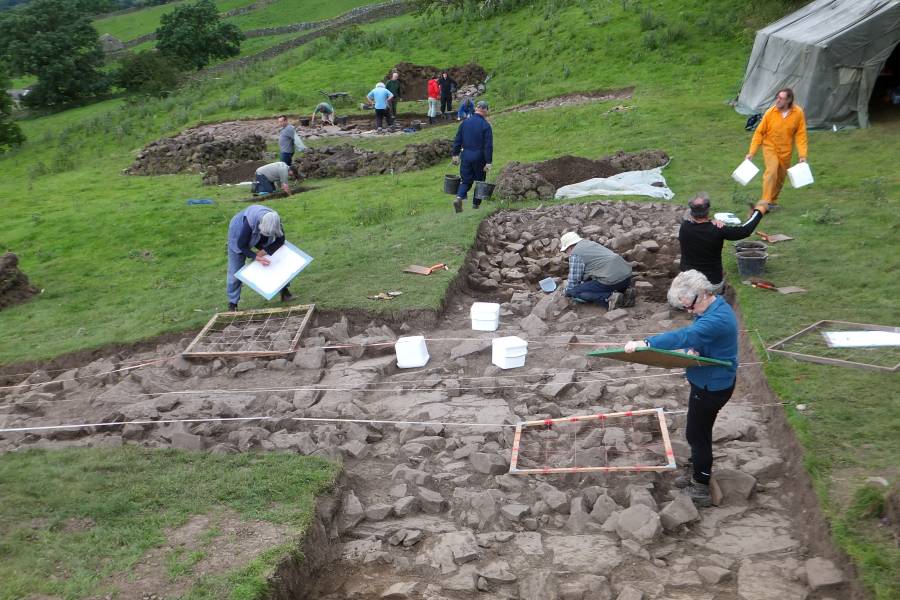 Trench 1 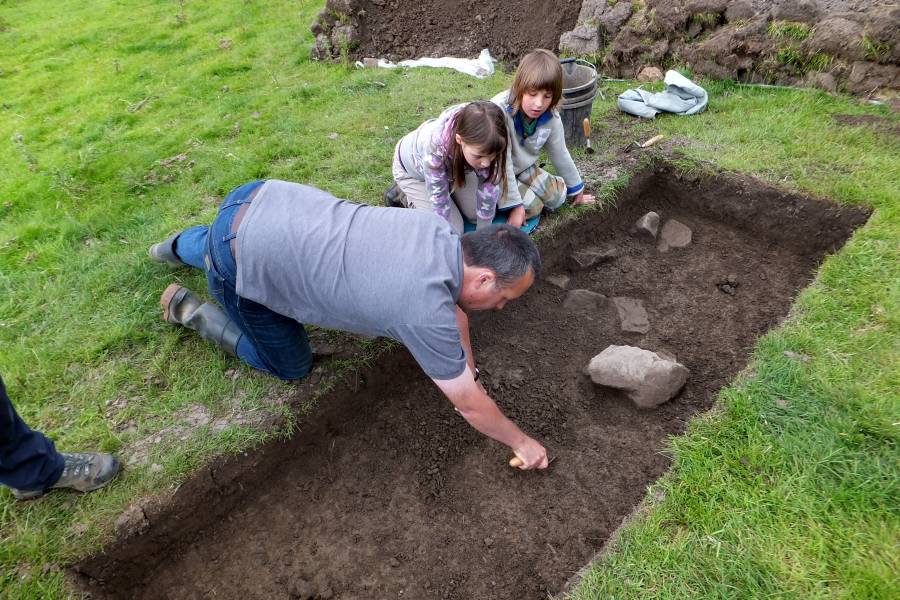 We haven't mentioned Trench 3. We have asked Justin and his two children to investigate a yard area close to the roundhouses. Here Tony from Archaeology Services Durham University is showing Justin's children, Tasmin and Harris, the art of troweling a trench ready for recording. 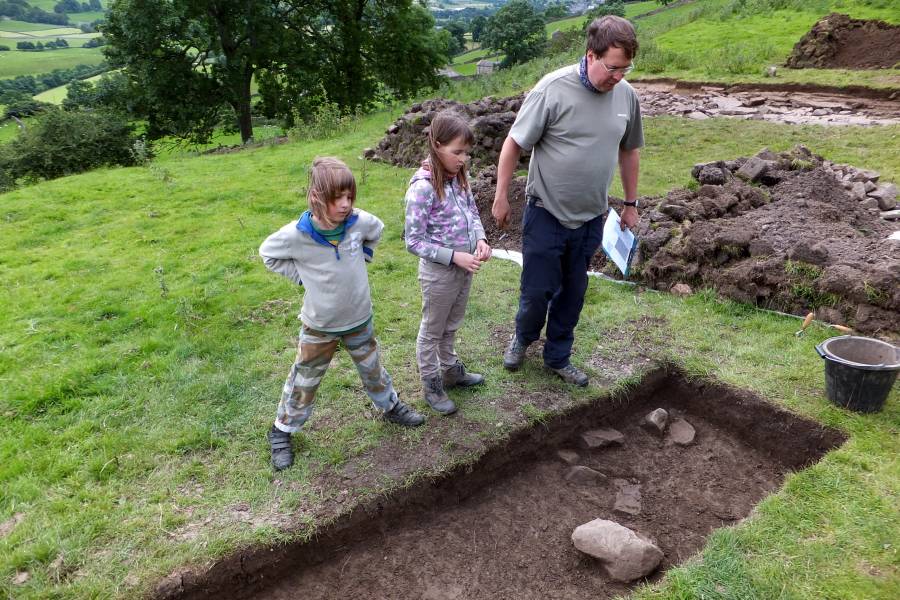 A job well done. 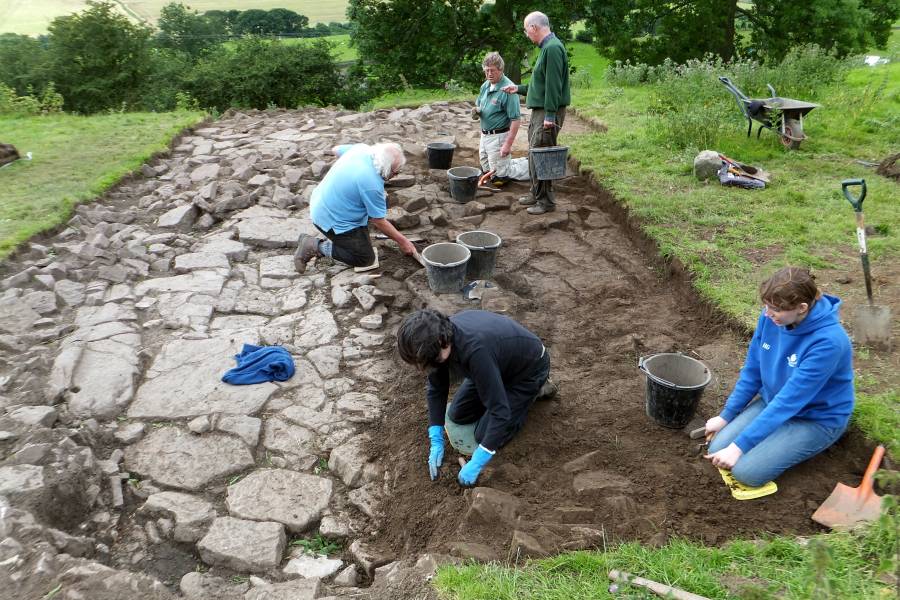 In Trench 2 we have cleared another 2 metres of the roundhouse. We hope to complete this tomorrow morning when we should be able to estimate how much more needs removing to see the whole of the floor plan. This is Hannah's first dig (right) which was marked by 2 finds on a day when finds were rare. 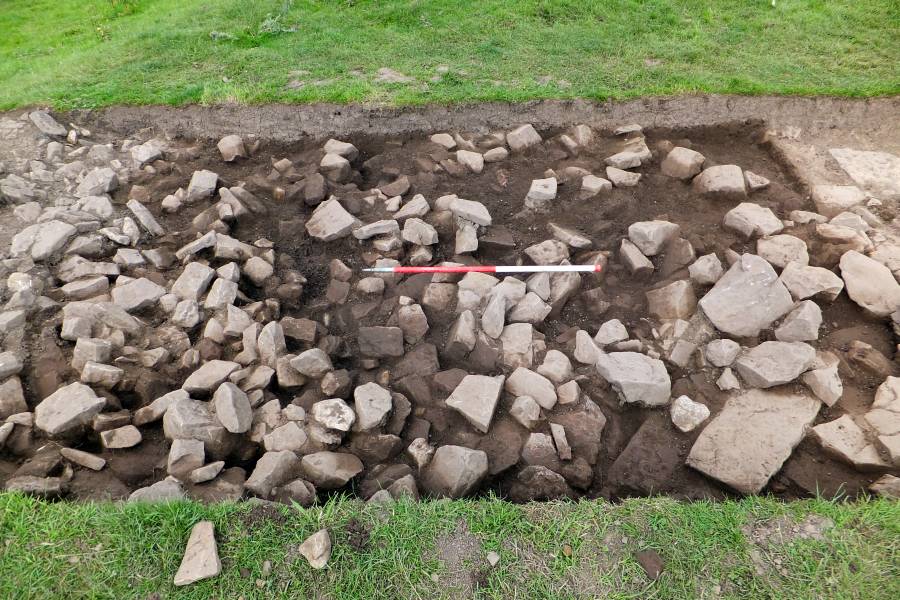 Back in Trench 1 the mid section ready for photographic recording. 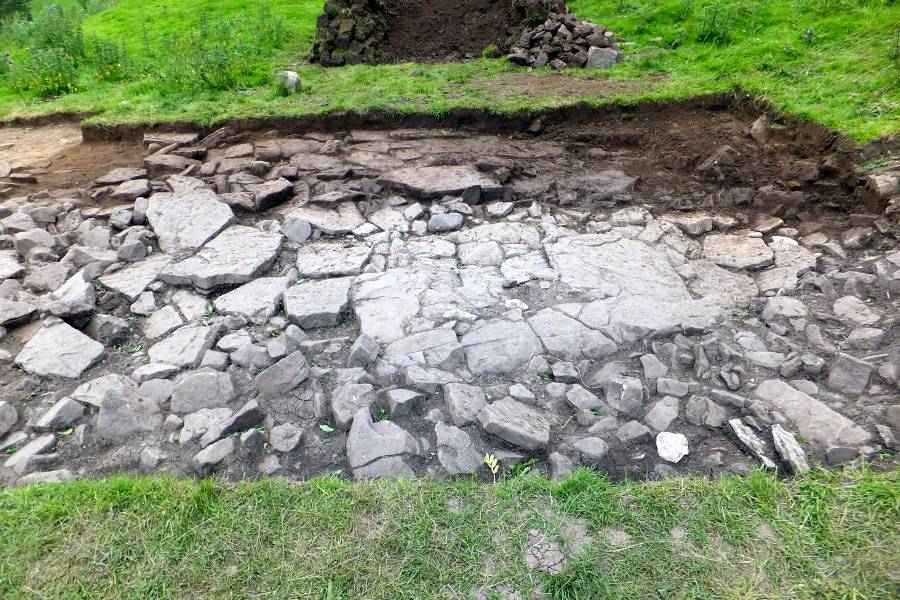 Trench 2 roundhouse at the end of day. |
| Day 7 July
24th.
Top of Page There was a lot of activity in both Trench 1 and 2. The main north south Trench has now been recorded, To the west of Trench 1 we have gone down a layer to a possible floor. One of the better pottery find was reveal by our videographer Mike. In Trench 2 we have found the full width of the main roundhouse floor, and we have take a section of the southern part of the trench down removing all the stone tumble. It is here we found our best piece if iron-age pottery. |
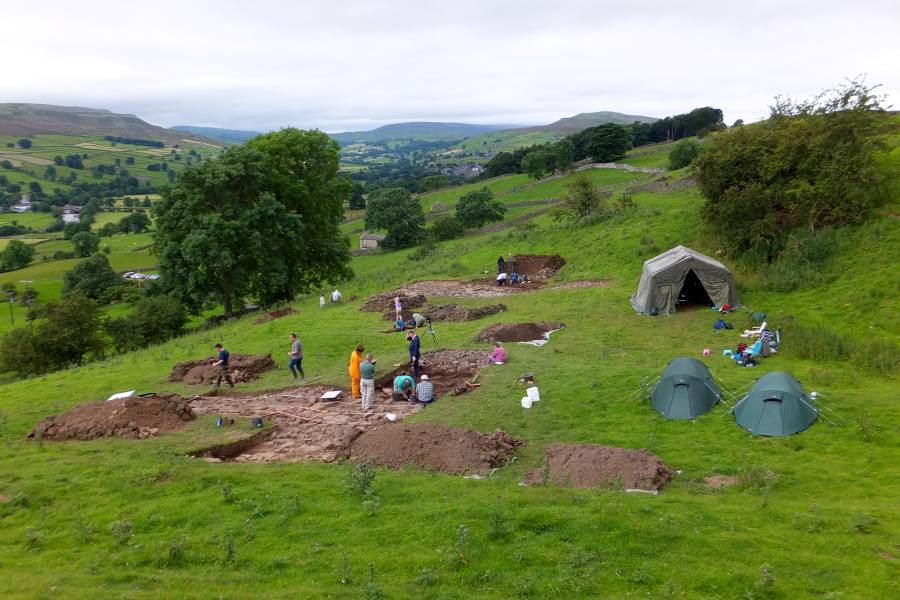 Activity in all trenches.  Taking the western part of Trench 1 down to a probably floor level. Where Mike is in the dark blue overall is near where he found the pottery sherd shown below (complete with worm). Note this sherd lies directly on top of the floor slab. 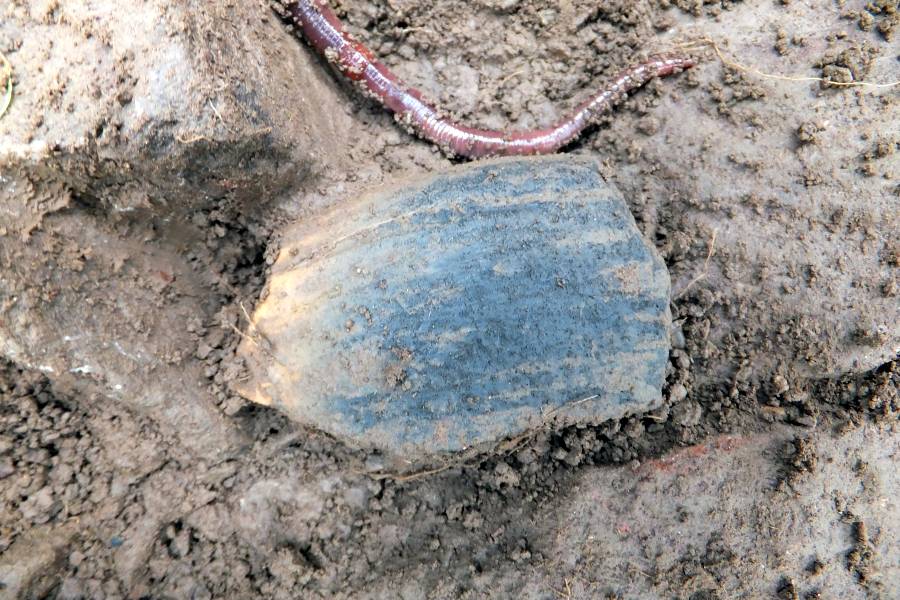 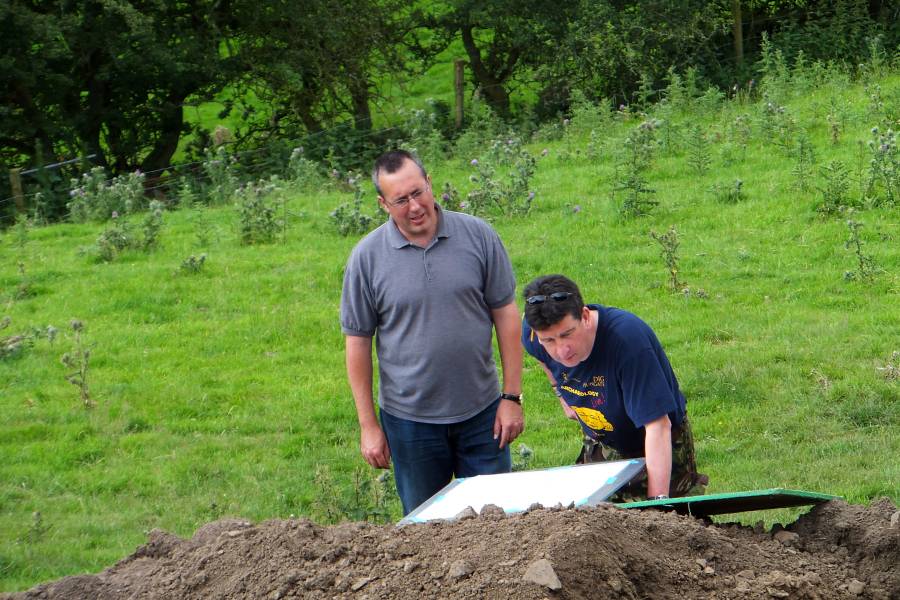 Tony (ASDU) and Philip looking at the amalgamated drawings of the stones in the north south part of Trench 1. 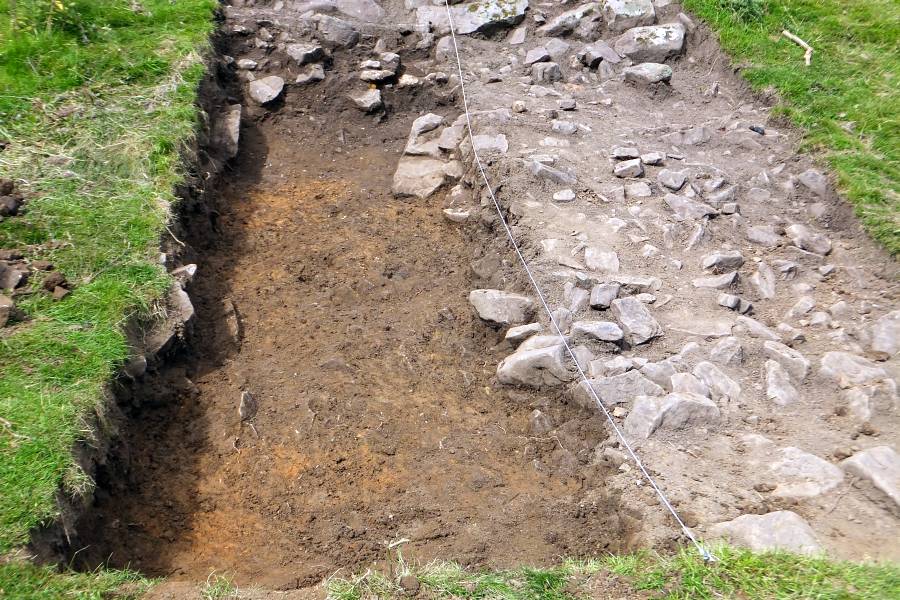 Southern end of Trench 2 where the iron-age pottery was found. 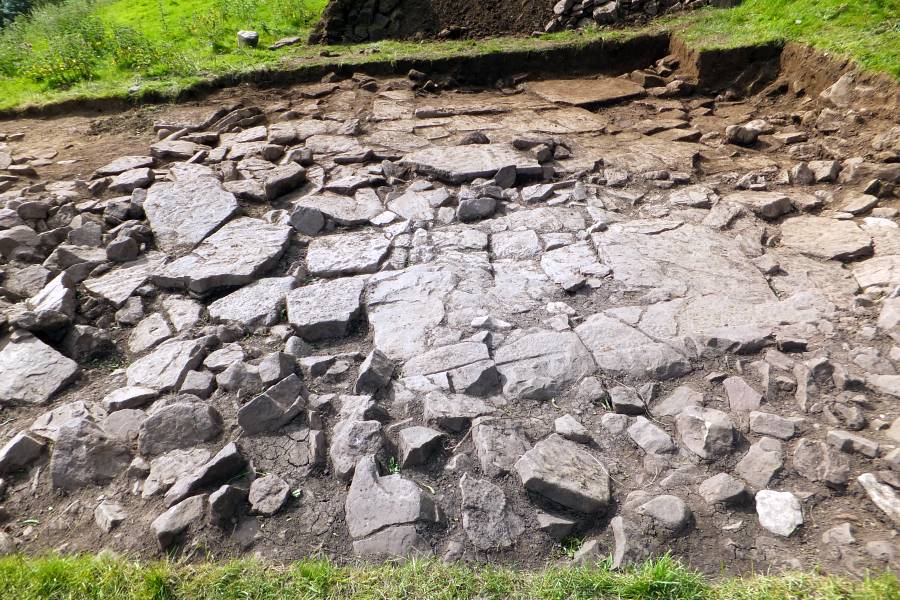 The full width of the roundhouse base in Trench 2. |
| Day 8 July
25th.
Top of Page Today was midge-hell day. Everyone was fed up with being bitten. But of course we soldiered on! Tony was doing a sterling job recording Trench 1 (see image below). We then started lifting the stone tumble off the southern extension to reveal the possible approach path or another floor. See third image. Whilst in Trench 2 we have finally come to the end of a marathon job of preparing the main roundhouse floor for recording. |
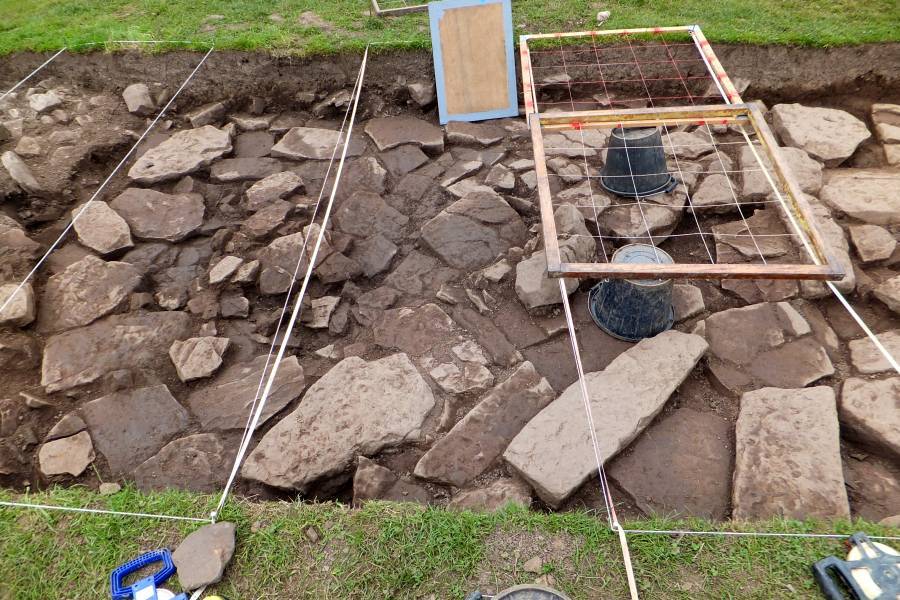 Trench 1. 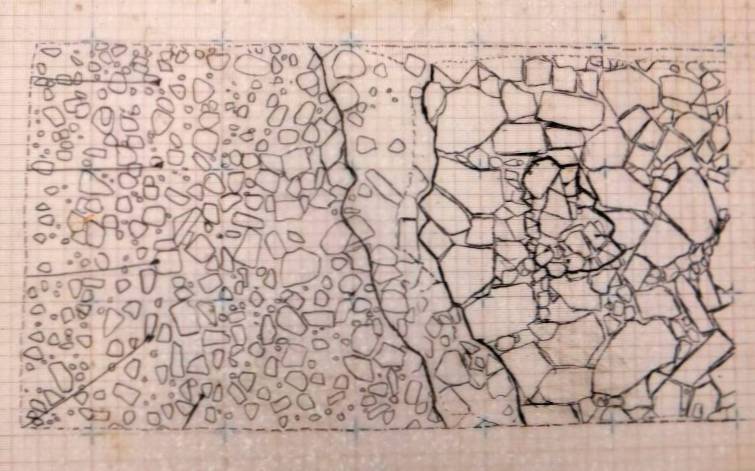 Recording part of Trench 1 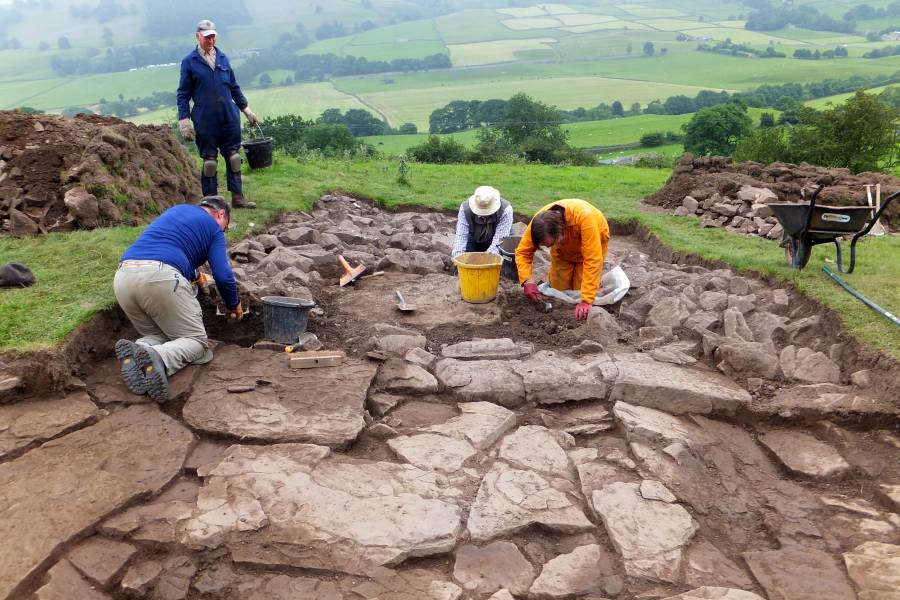 Starting to lift the tumble from the southern extension of Trench 1. 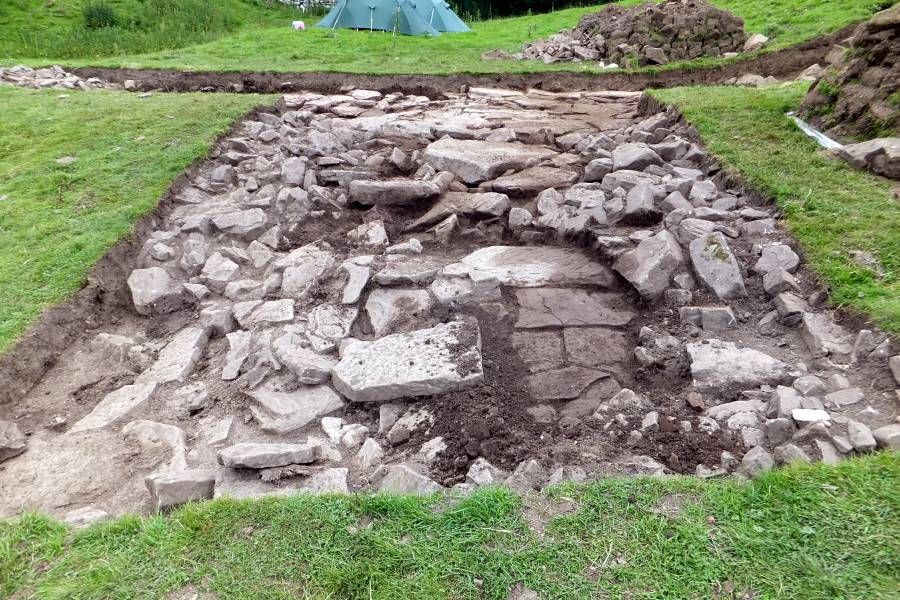 Removing the tumble from the southern extension to Trench 1. The beginnings of a floor or path beginning to appear. It will take a good part of tomorrow to complete this. 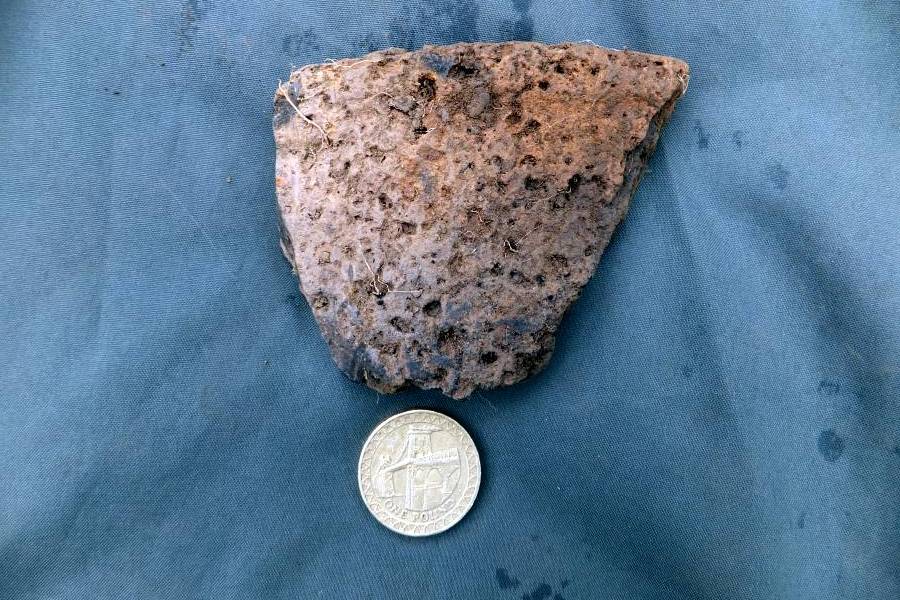 Iron-Age pottery from just above the floor level of Trench 1. 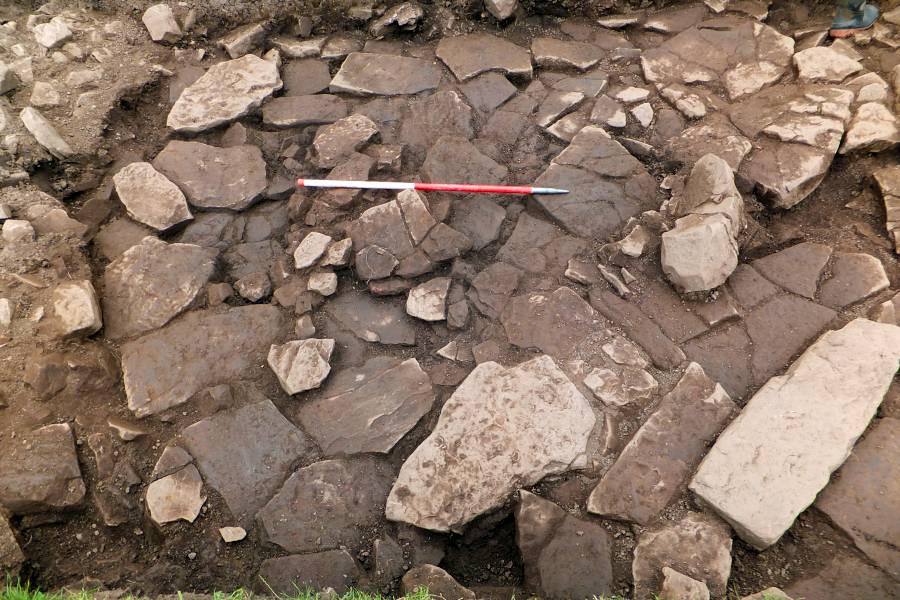 Western end of Trench 1 just inside the rubble bank far left. 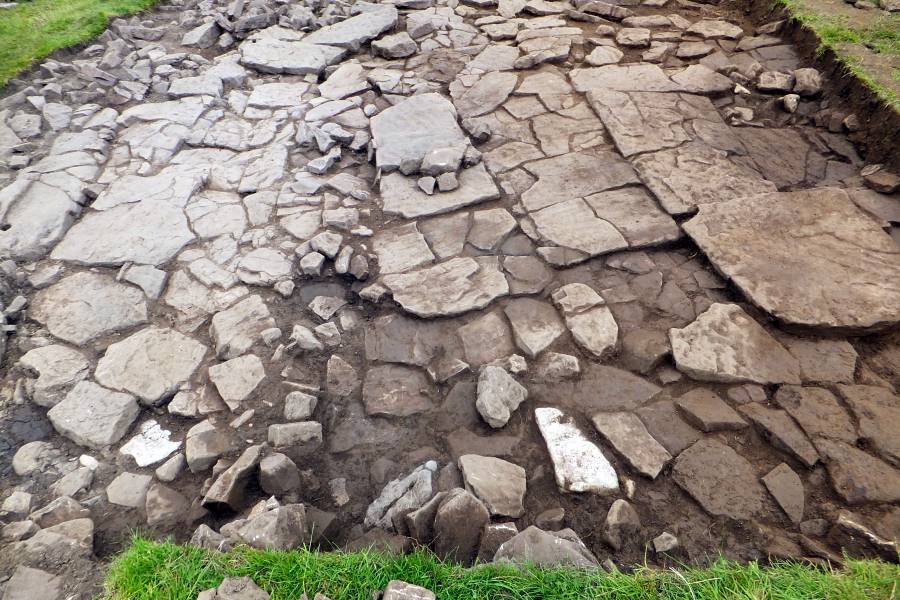 Main roundhouse in Trench 2. Again Iron-Age pottery found from just above the floor level in the lower sub-soil. 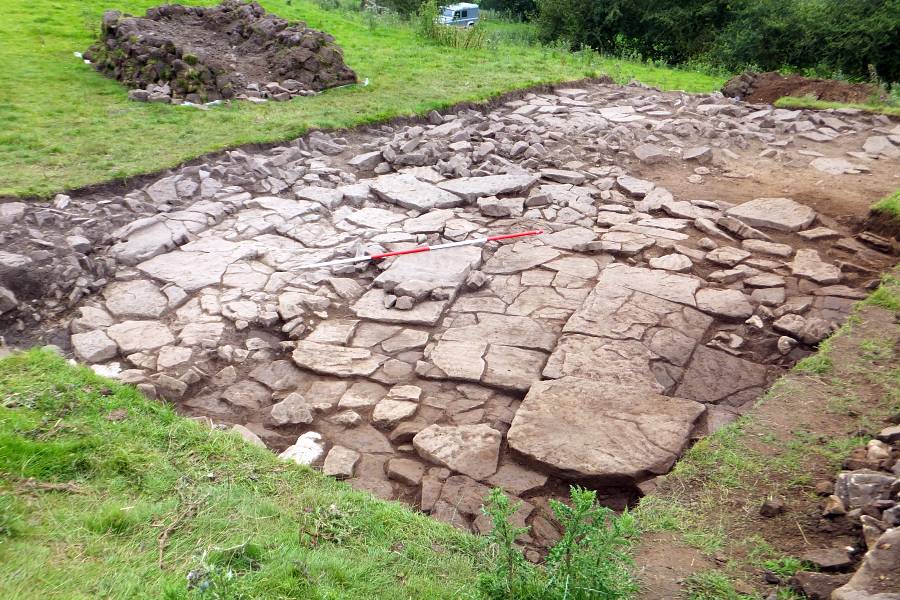 Another view of this roundhouse base. |
| Day 9 July
26th.
Top of Page Unfortunately for two students from Lancaster, Emma and Zaneta, they chose the wettest day of the dig to come and help out. The did find the 4th piece of flint found on the site. The nearest source of flint is the East Yorkshire coast. A large part of the day was spent recording the main roundhouse site in Trench 2, a serious amount of stonework to draw! We also made progress taking off the tumble layer of stones on the southern extension to Trench 1. It looks like an approach path of flagstones has been revealed, although one stone seems to have been robbed out at some stage. Finally Stephanie and David have been surveying the excavation site and trenches. |
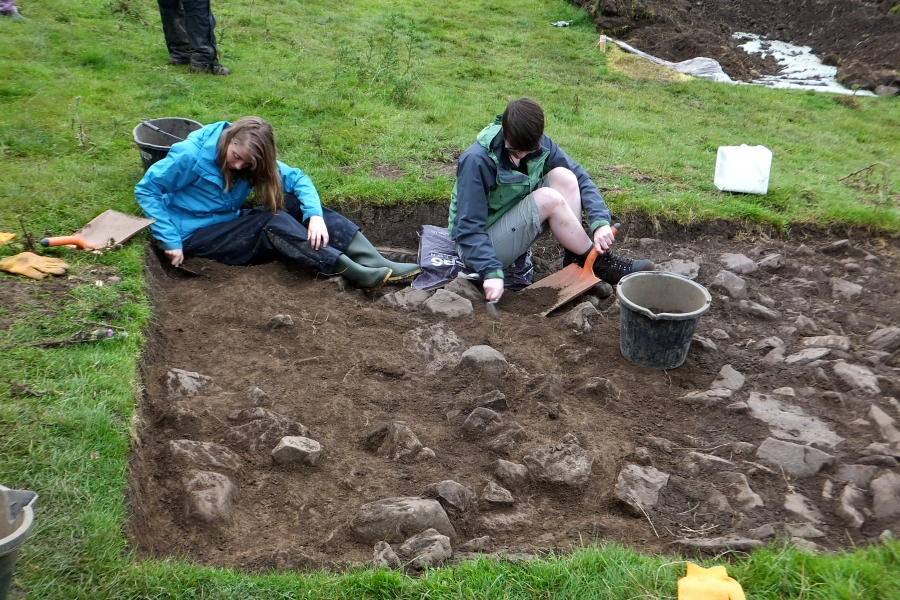 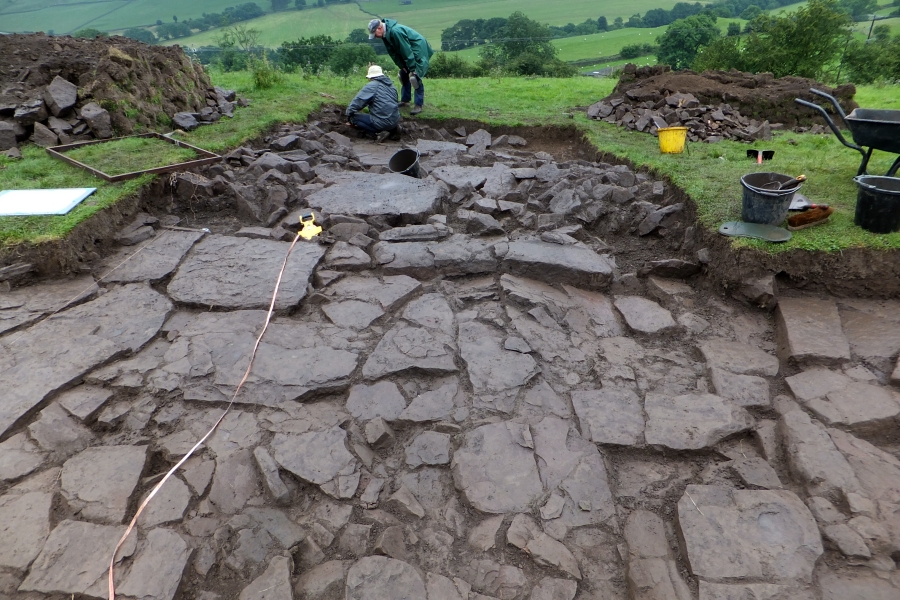 Mike and Graeme removing tumble from what appears to be an approach path to the site. See below too. 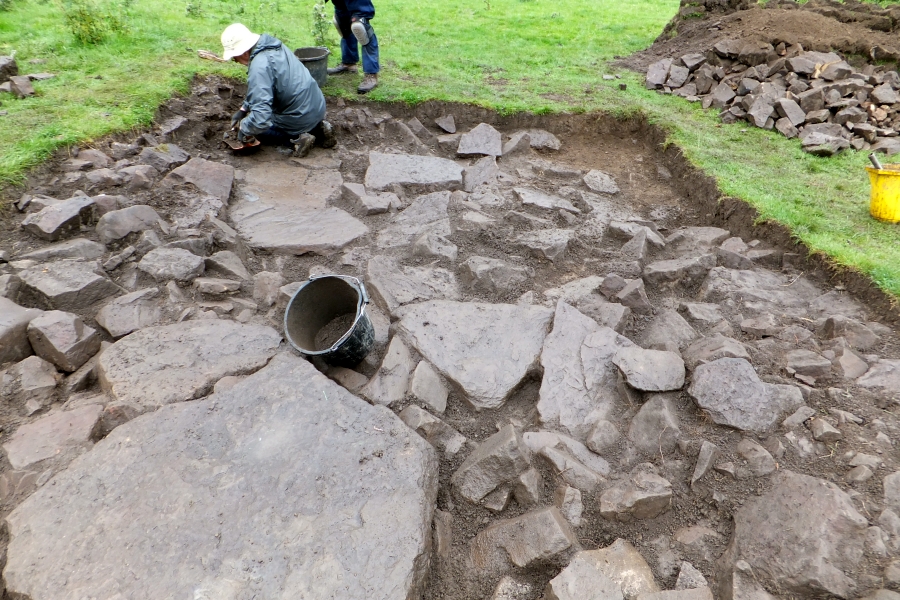 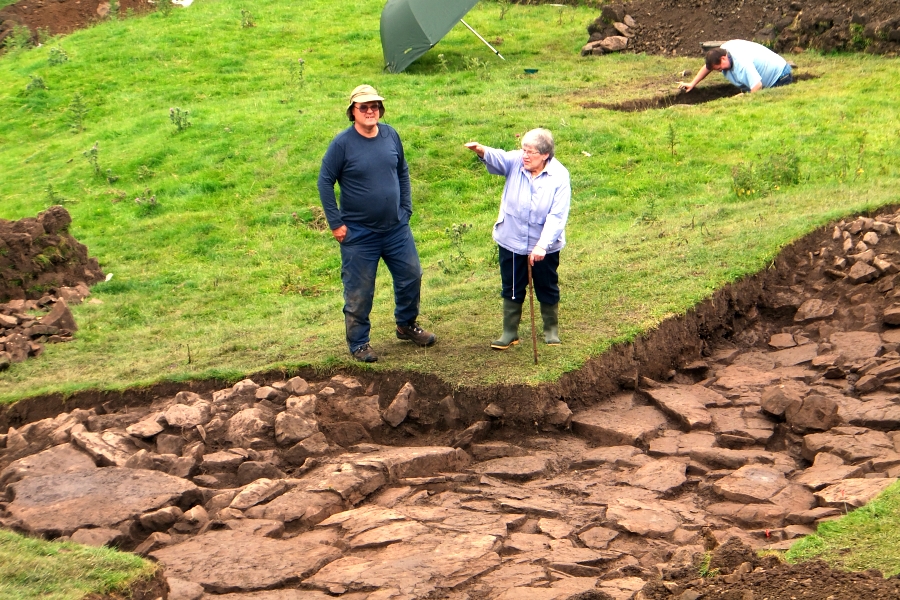 Mary Clark talking to David about what we have found. |
| Day 10 July
27th.
Top of Page The last day of this dig at Hagg Farm. The remaining 2 days are backfilling days. Whilst the emphasis was on completing the recording of the site, there was some interesting developments. At the end of the day Tim Laurie gave an excellent summary describing the how settlements of this type fitted into the the Iron Age / Roman-British landscape, and Tony from ASDU suggested what areas of the site SWAAG may want to investigate next. This was videoed and will appear at the end of this blog in the next few days when it has been edited. Follow the day with the images below. |
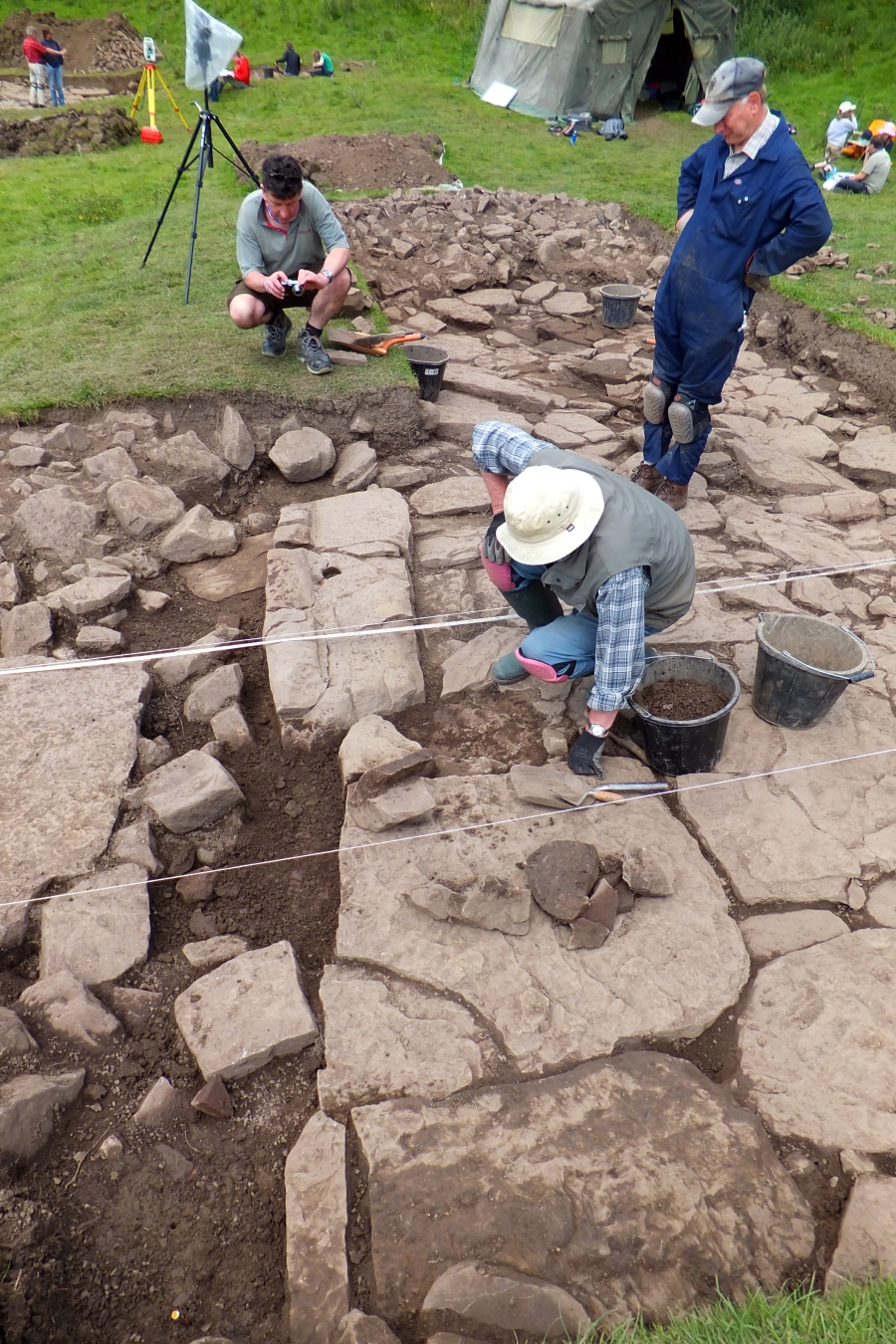 Graeme assisted by Philip, realised that several missing parts of this doorway sill were present but inverted in the soil. There were carefully put back into position so that they could be recorded. 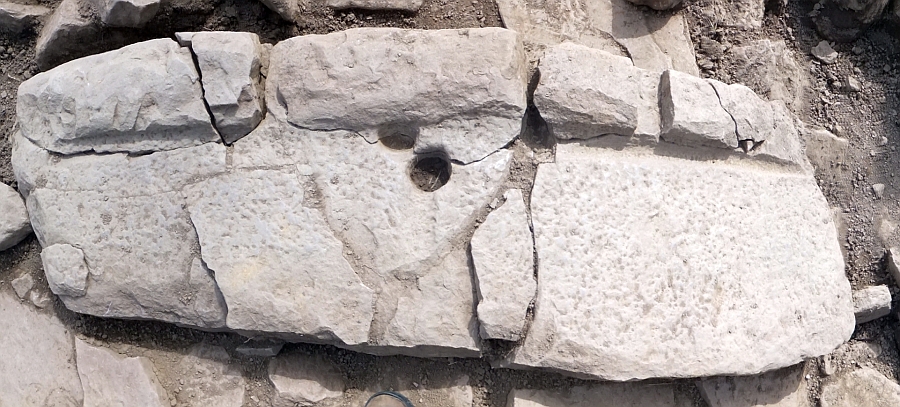 This shows the relocated pieced back in position. It does suggest possibly 2 overlapping doors both secured (bolted) into the holes. First the left then the right door. It appears to be quite uncommon for this type of British buildings to have these Roman type of door sills, and we have found 2 examples so far on this site. 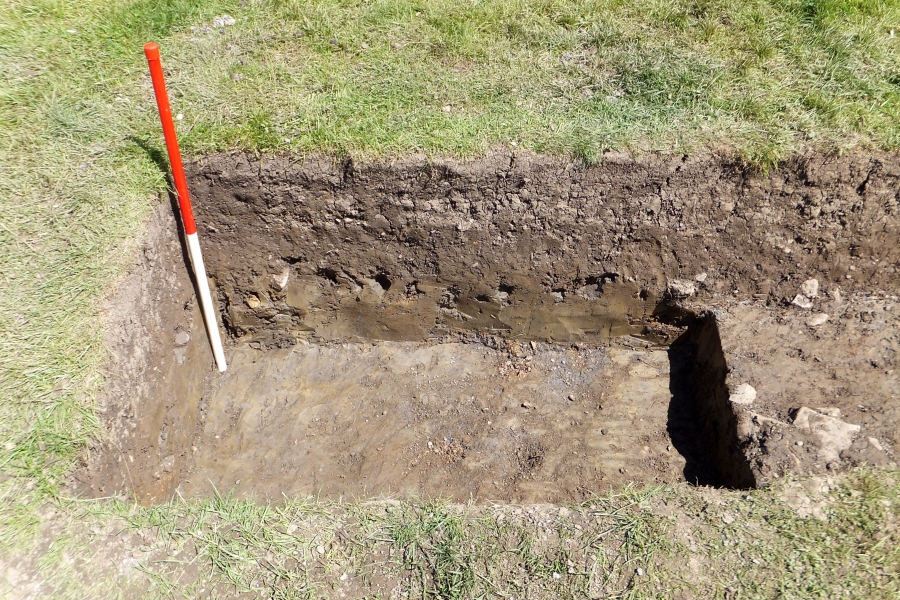 In Trench 3: Justin, Tamsin and Harris trench, we were surprised to find very little. This trench was located in what we thought was a courtyard area between the outer banks and the main roundhouse platforms. We expected to have some sort of paved surface and a number of finds. In fact we essentially found neither. Was this a garden area? We need to investigate more. 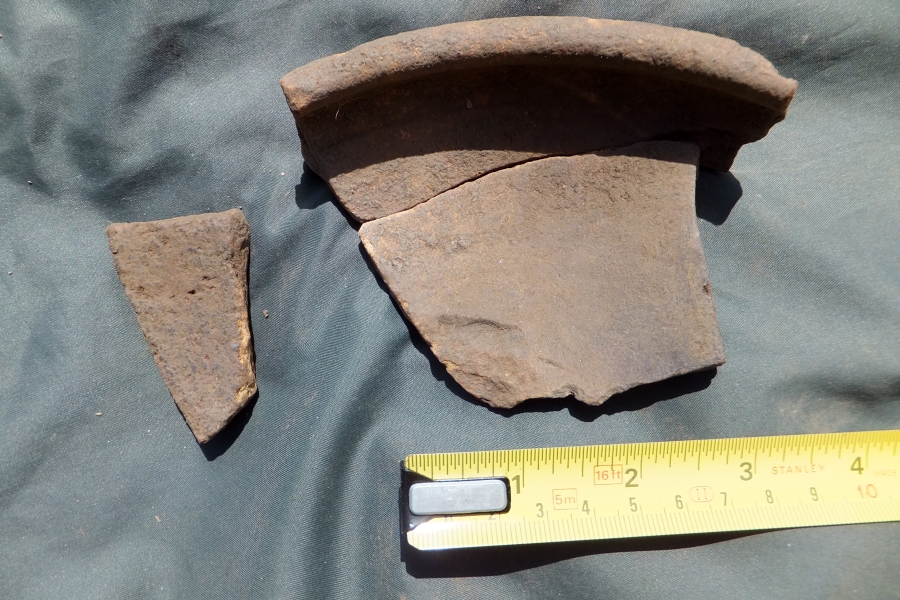 These 3 pieces of pottery were found inbetween the floor flags of the main roundhouse. The lefthand sherd appears to be Iron-Age and the other two Romano-British. See the next 2 images below: 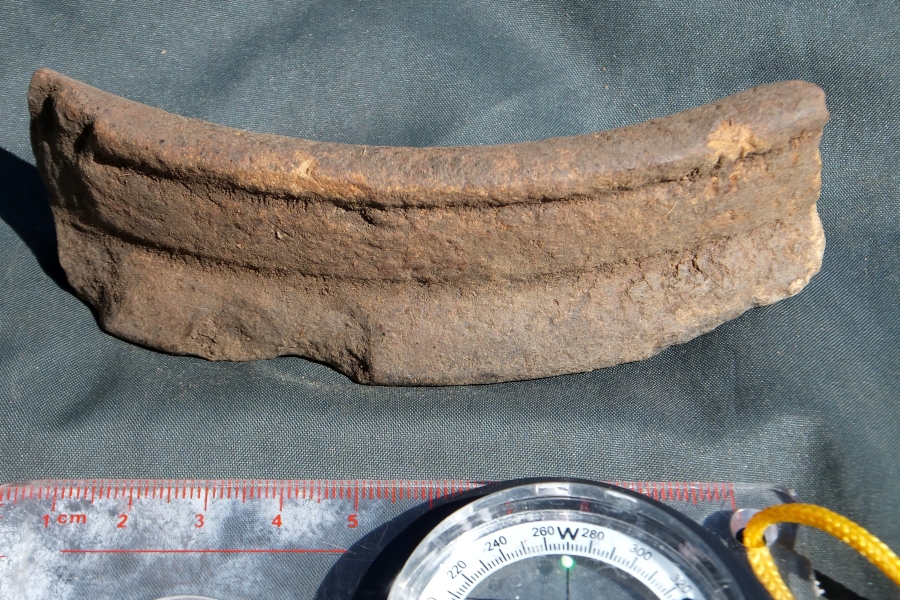 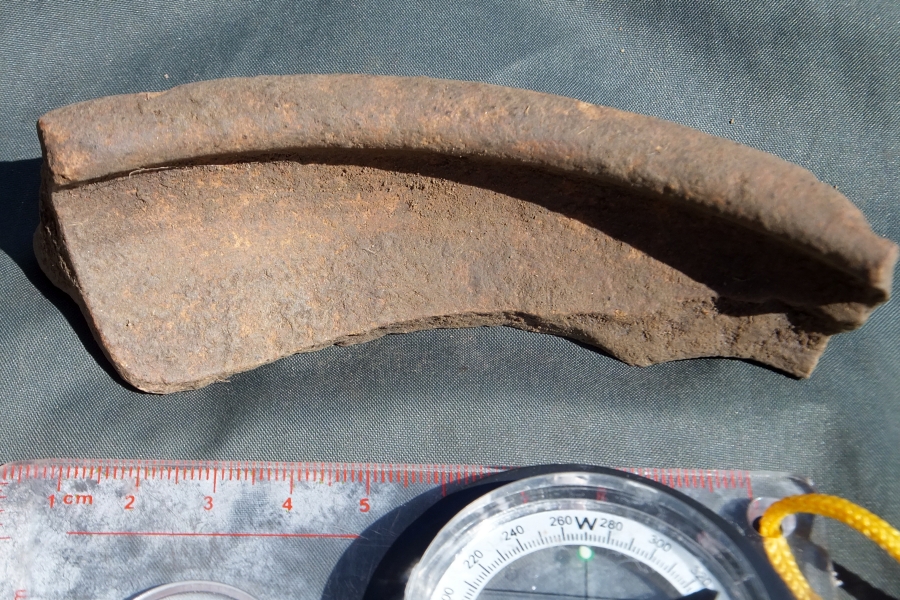 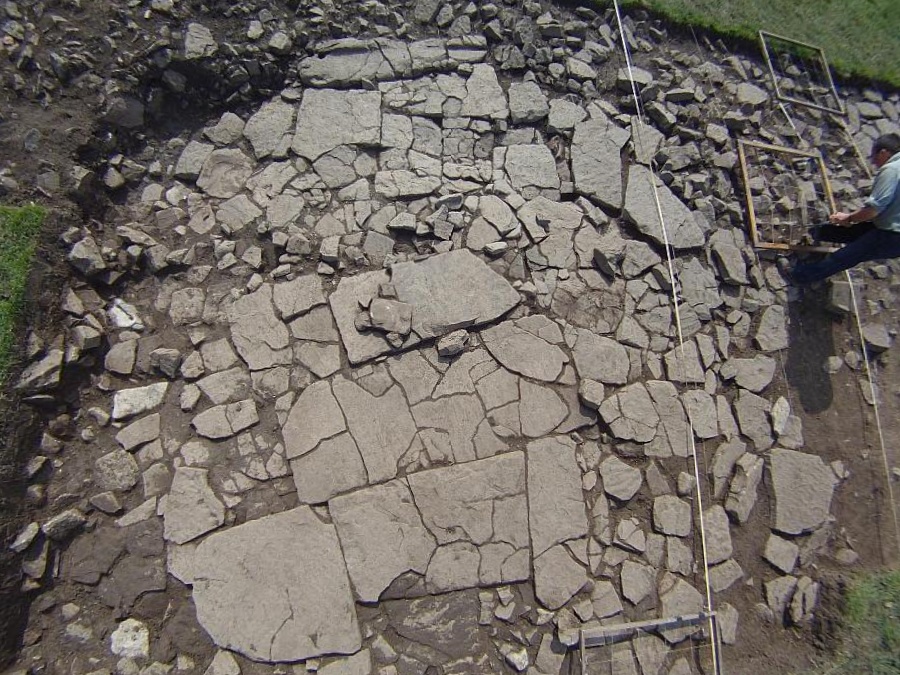 A view of the roundhouse. There could well be 3+ phases of use. 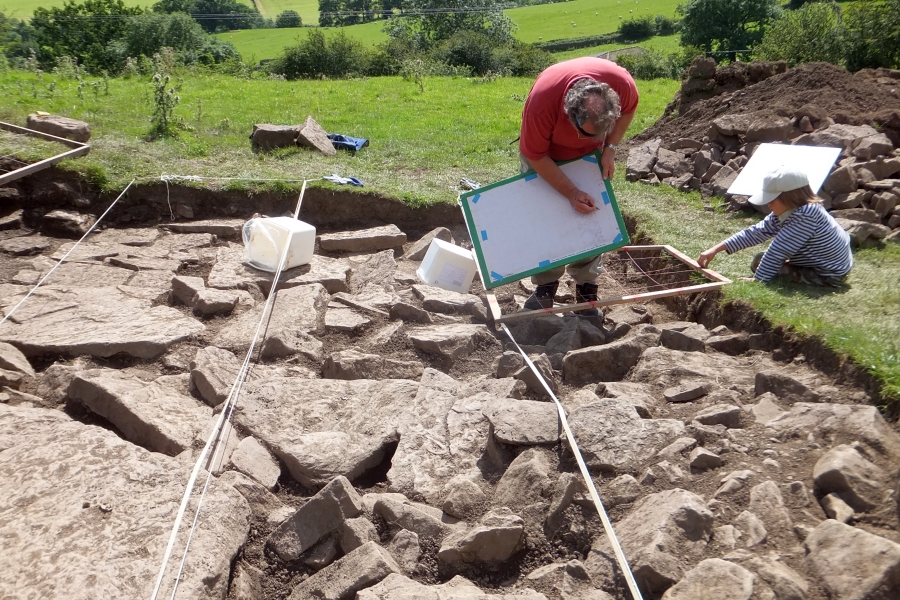 Finally David is left working on his own completing the last drawings closely supervised by Harris. 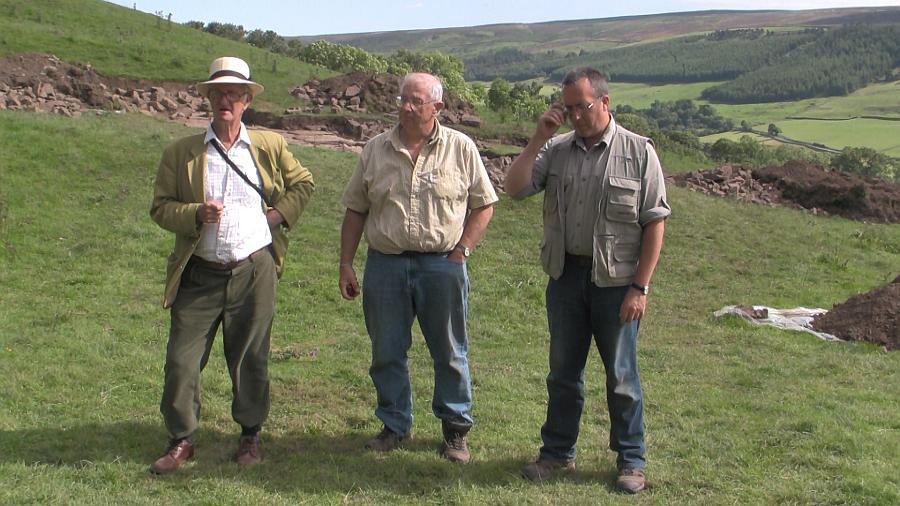 Tim Laurie (left) concluding the dig by describing how these Iron-Age / Roman-British sites featured in the pastural landscape of Swaledale. Tony Liddell (right) was the Lead Archaeologist from Archaeology Services Durham University. SUMMARY: Whilst we have included images of a number of finds, there were many more smaller pottery finds. The most outstanding finds may be the pottery in todays blog and the glass bangle found on Day 2 above. Just as interesting is what we didn't find. The 2 most surprising are the lack of evidence of hearths and burning, and the lack of butchered animal bone. There are at least 2 other substantial platforms which are good candidates for occupation. It would be lovely to find a midden too. |
| Week 2 Video |
|
|
| Day 11 July
30th.
Top of Page |
| Alas no images or report as I was away whilst the team did a sterling job backfilling Trenches 1 and 3. |
| Day 12 July
31st.
Top of Page The last day of the dig. I will add in final image in a few weeks time to see how the site has recovered. |
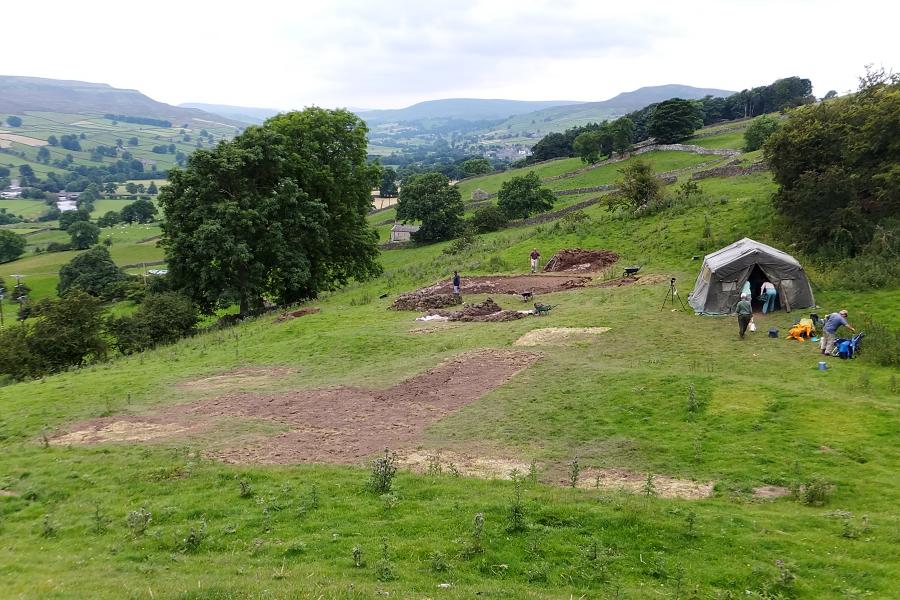 Lunchtime of the final day 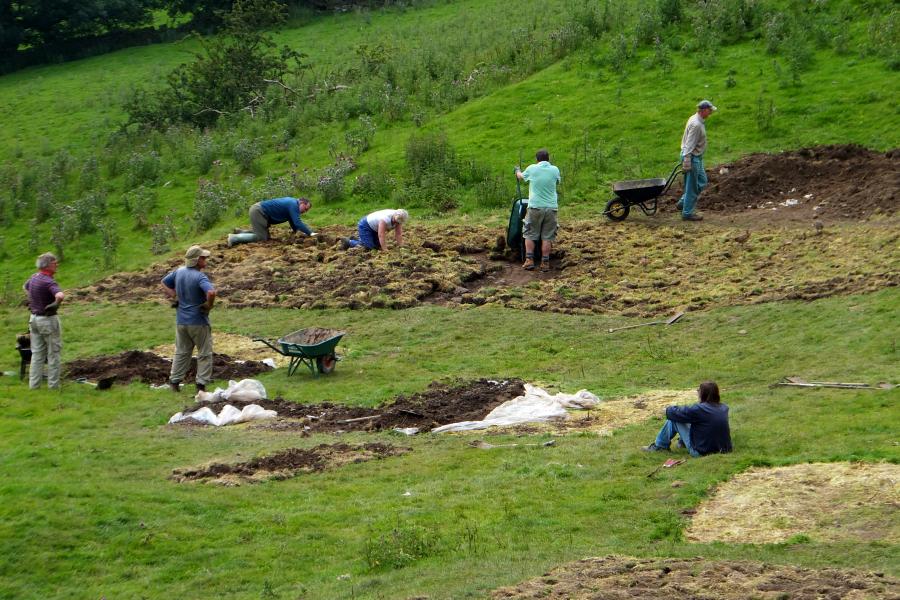 Fatigue setting in and thoughts of a pint might become a reality soon. 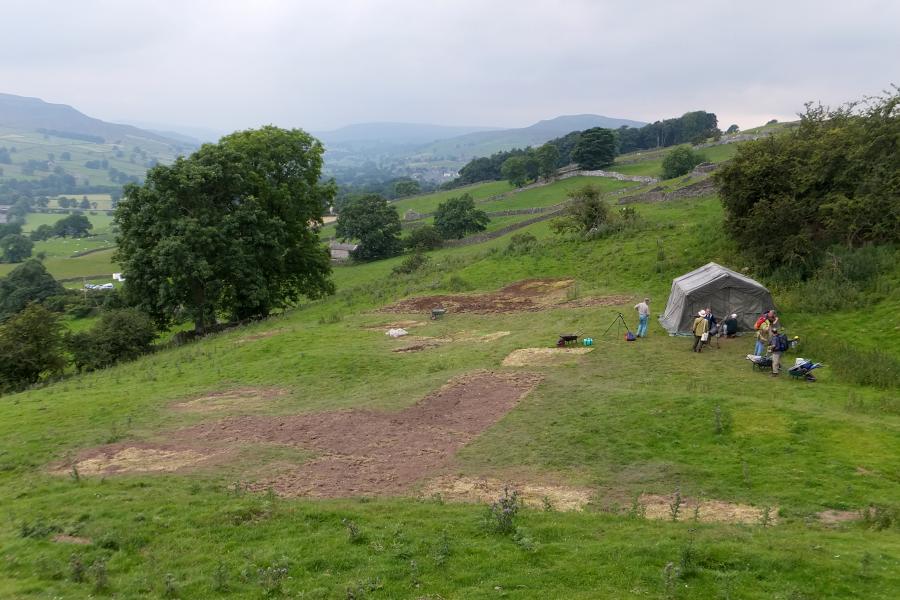 All done! 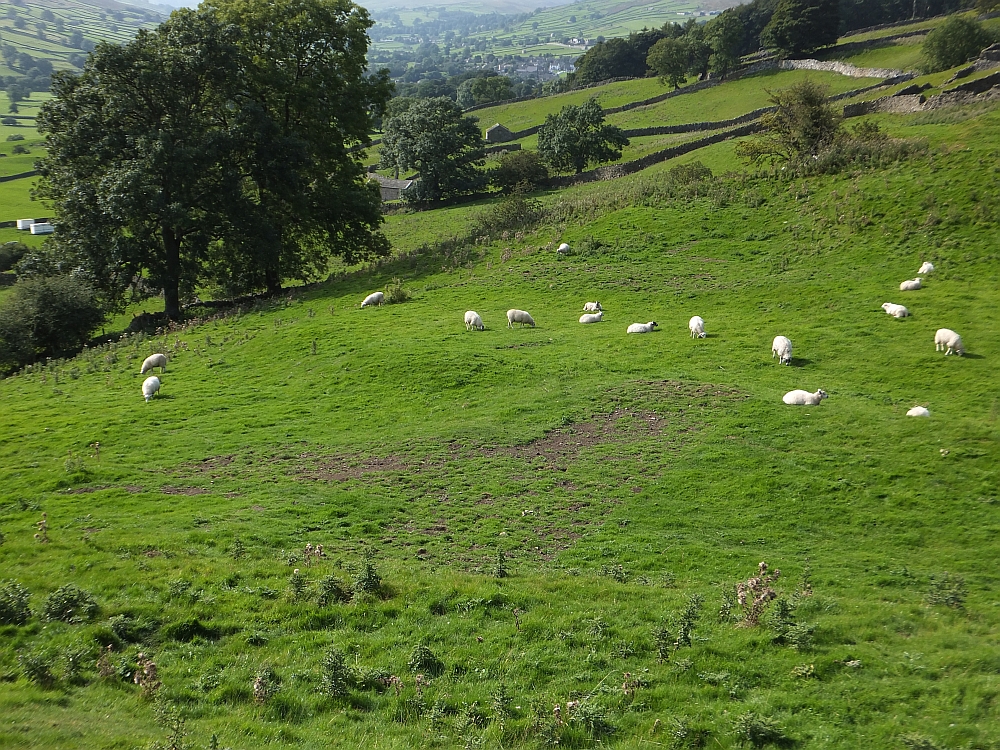 Photo taken 15/09/2012 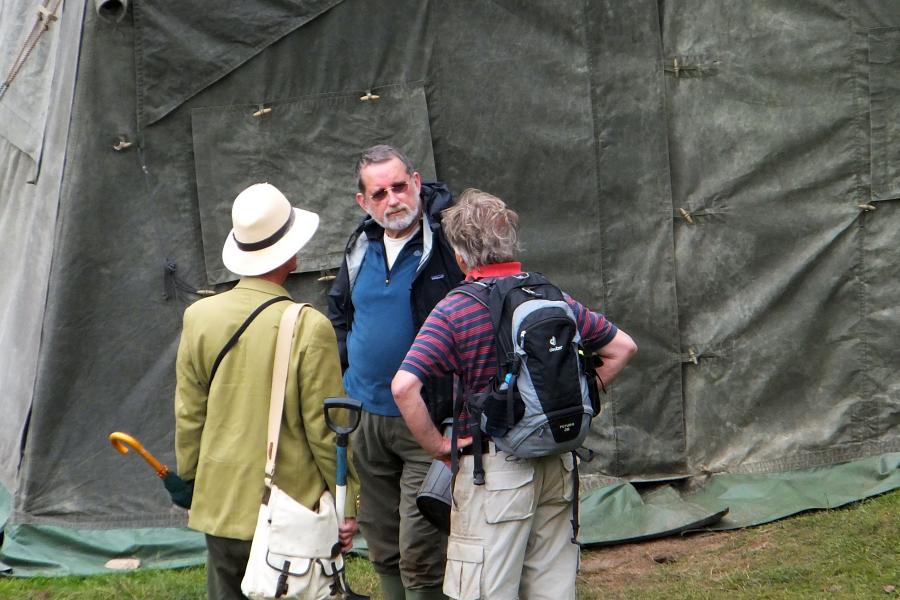 Good to see Peter back in Swaledale - here talking to Tim and David. Backfilling days |
More Images (Wide screen and will take time to load depending on your broadband speed) Swaledale Project Video page |
| ©SWAAG (swaag.org) 2012 Images © S Eastmead (swaag.org) Video © M Walton (swaag.org) Use the Contact page for © permissions. |